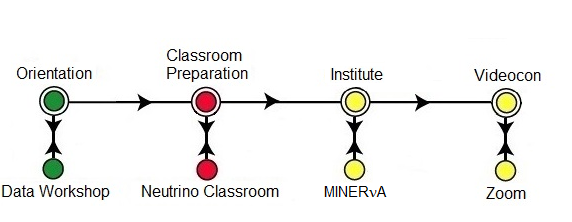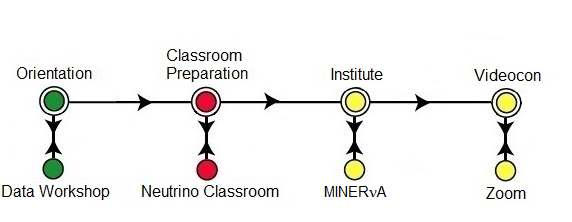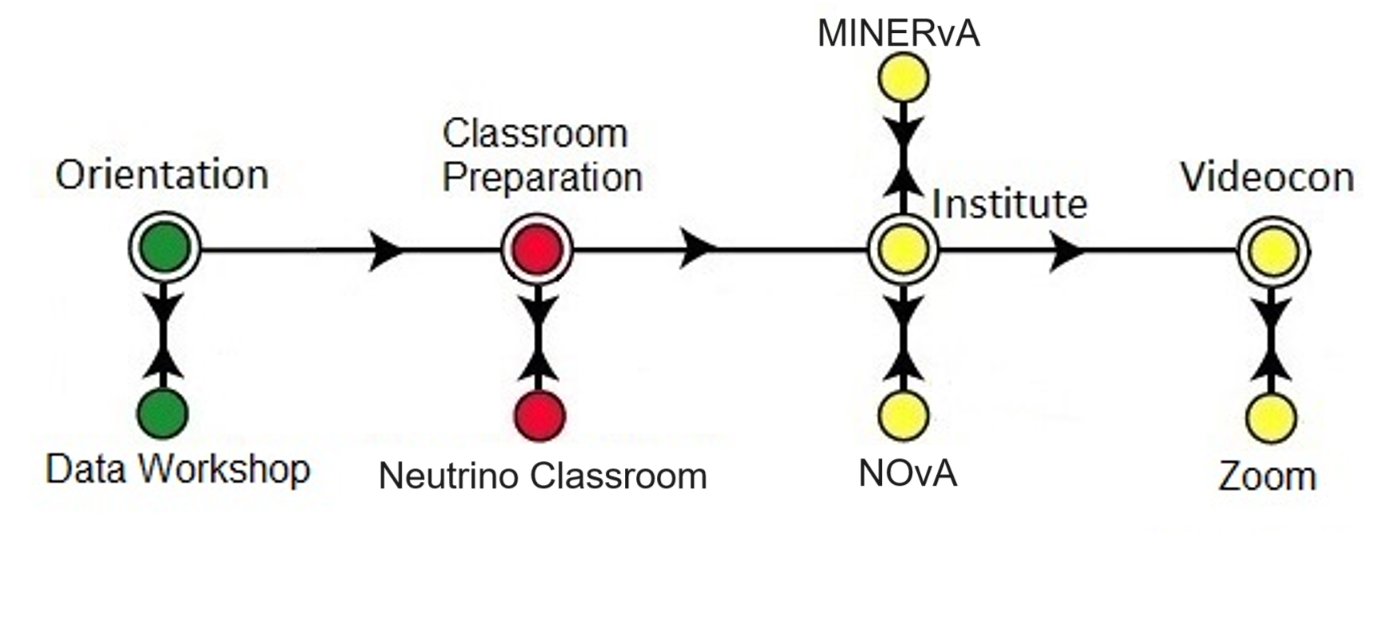LHC and Neutrino Masterclass 2024 Archive
Moderators
Small URL for this page: https://cern.ch/fnal-mod.
Moderator Orientations
CERN: Feb 12, 2024, see Indico page for recordings.
FNAL:
- Orientation meeting Feb 27, 14:00 CET, Fermilab WH7XO or Zoom
- Make-up/Q&A Feb 29 on Zoom only.
Reference Materials
| Orientation Videos | Virtual Visit Videos | Documents | Q&A |
|---|---|---|---|
|
Options
|
FNAL
2024 Schedule for ATLAS masterclass videoconferences moderated by Fermilab
Times (TBA) are in U.S. Central Time. (Convert to your time zone.) This schedule is in its prelimiary stages and is subject to change.
| Date/time (U.S. Central Time) | Institutes | Moderator(s) | Staff | Virtual Visit | Zoom link |
|---|---|---|---|---|---|
| Mon 04 Mar/15:00 | Stillwater | Norberg | Cecire | vcvv2024_dir | cern.ch/fnal-imc-a |
| Fri 08 Mar/15:00 | Ruston, Stillwater - joint ATLAS/CMS | Natale, Hogan | Cecire | cern.ch/fnal-imc-b | |
| Sat 09 Mar/15:00 | Notre Dame, Santa Cruz, Stillwater - joint ATLAS/CMS | Natale, Malik | Wetzler | cern.ch/fnal-imc-b | |
| Tue 12 Mar /13:00 | DeKalb | Smith | Cecire | ATLAS Vis Ctr | cern.ch/fnal-imc-a |
| Sat 16 Mar/14:00 | DurhamNC, Stillwater, Turlock | Bhopatkar | Glover | cern.ch/fnal-imc-a |
*U.S. Daylight Savings Time begins. The schedule continues with the same local time intervals for
Fermilab but move one hour ahead in non-U.S. time zones.
2024 Schedule for CMS masterclass videoconferences moderated by Fermilab
Times(TBA) are in U.S. Central Time. (Convert to your time zone.) This schedule is subject to change.
| Date/time (U.S. Central Time) | Institutes | Moderator(s) | Staff | Analysis | Virtual Visit | Zoom link |
|---|---|---|---|---|---|---|
| Fri 01 Mar/14:00 | ManhattanKS | Capdevilla, Wood | Cecire | CIMA | vcvv2024_dir | cern.ch/fnal-imc-c |
| Fri 01 Mar/15:00 | CDMX-Ibero | Capdevilla, Hall | Cecire | CIMA | vcvv2024_dir | |
| Sat 02 Mar/14:00 | Houston | Smith | Cecire | Google Sheet at cern.ch/fnal-02mar2024 | ATLAS Vis Ctr | cern.ch/fnal-imc-c |
| Fri 08 Mar/15:00 | Hammond - joint ATLAS/CMS | Hogan, Natale | Cecire | CIMA | cern.ch/fnal-imc-b | |
| Sat 09 Mar/14:00 | Frontino, Hermosillo, Navojoa, Nogales - español | Capdevilla | Wetzler | CIMA | cern.ch/fnal-imc-c | |
| Sat 09 Mar/15:00 | Boston - joint ATLAS/CMS | Malik, Natale | Wetzler | CIMA | cern.ch/fnal-imc-b | |
| Sun 10 Mar*/14:00 | Baltimore | Natale | Wetzler | Google Sheet, at cern.ch/fnal-10mar2024 | cern.ch/fnal-imc-c | |
| Wed 13 Mar/10:00 | Puebla-BUAP 1 - español | Ventura | Cecire | CIMA | cern.ch/fnal-imc-c | |
| Thu 14 Mar/09:00 | New York | Uribe | Glover | CIMA | cern.ch/fnal-imc-c | |
| Thu 14 Mar/15:00 | Puebla-Zapata, CDMX-PrepaIbero - español | Uribe | Wadness | CIMA | cern.ch/fnal-imc-c | |
| Fri 15 Mar/20:00 | Auckland, Honolulu | Albrow, Boye | Cecire | CIMA | cern.ch/fnal-imc-c | |
| Sat 16 Mar/15:00 | Medellin, CDMX-Cinvestav, Puebla-BUAP 2, Quito - español | Vazquez | Glover | CIMA | cern.ch/fnal-imc-c | |
| Thu 21 Mar/14:00 | Osorio, Londrina - portugues | Andrijauskas, Maeshima | Wood | Google Sheet at cern.ch/fnal-21mar2024 | cern.ch/fnal-imc-c | |
| Fri 22 Mar/17:00 | Seattle | Hall | Cecire | CIMA | vcvv2024_dir | cern.ch/fnal-imc-c |
| Sat 23 Mar/14:00 | Orange, Williamsburg | Malik | Wetzler | Google Sheet at cern.ch/fnal-23mar2024 | cern.ch/fnal-imc-c | |
| Sat 23 Mar/15:00 | Montelibano - español | Vazquez | Wetzler | CIMA | cern.ch/fnal-imc-b | |
| Tue 26 Mar/09:00 | Cluj-Napoca | Capdevilla | Wood | CIMA | cern.ch/fnal-imc-c | |
| Wed 27 Mar/11:45 | Rochester, Rio de Janeiro | Rahmat | Cecire | CIMA | cern.ch/fnal-imc-c |
*U.S. Daylight Savings Time begins. The schedule continues with the same local time intervals for
Fermilab but move one hour ahead in non-U.S. time zones.
2023 Schedule for MINERvA masterclass videoconferences moderated by Fermilab
imes (TBA) are in U.S. Central Time. (Convert to your time zone.) This schedule is in its prelimiary stages and is subject to change.
| Date/time (U.S. Central Time) | Institutes | Moderator(s) | Staff | Analysis Spreadsheets | Virtual Visit | Zoom link |
|---|---|---|---|---|---|---|
| Fri 08 Mar/15:00 | Lead, Vermillion | Junk, Olivier | Pasero | FNAL-NuMC-2024–03-08 | MINERvA Zoom Link | |
| Sat 16 Mar/14:00 | Duluth, Mayaguez | Martinez | Sedita | FNAL-NuMC-2024–03-16a | MINERvA Zoom Link | |
| Sat 16 Mar/17:00 | Irvine | Olivier | Sedita | FNAL-NuMC-2024–03-16b | MINERvA Zoom Link | |
| Fri 22 Mar/09:00 | Constantine | Junk, Olivier | Cecire | FNAL-NuMC-2024–03-22 | MINERvA Zoom Link | |
| Fri 22 Mar/10:00 | DurhamUK | Junk, Olivier | Cecire | FNAL-NuMC-2024–03-22 | MINERvA Zoom Link | |
| Mon 25 Mar/09:00 | Valencia | Junk | Pasero | FNAL-NuMC-2024–03-25 | MINERvA Zoom Link |
*U.S. Daylight Savings Time begins. The schedule continues with the same local time intervals for
Fermilab but move one hour ahead in non-U.S. time zones.
NOvA masterclass videoconference moderated by Fermilab
Times (TBA) are in U.S. Central Time. (Convert to your time zone.) This schedule is in its prelimiary stages and is subject to change.
| Date/time (U.S. Central Time) | Institutes | Moderator(s) | Staff | Virtual Visit | Zoom link |
|---|---|---|---|---|---|
| Sat 02 Mar/14:00 | Buffalo | Pawloski | Wood, Hodges | NOvA Zoom link | |
| Sat 09 Mar/15:00 | Minneapolis | Fields | Wood? | NOvA Zoom link | |
| Sun 10 Mar*/15:00 | Fort Collins | Norrick, Pawloski | Plucinski | NOvA Zoom link | |
| Thu 21 Mar/13:00 | Puerto Colombia | Fields, Ochoa-Ricoux | Wood | NOvA Zoom link | |
| Wed 27 Mar/14:00 | Curitiba | Norrick, Ochoa-Ricoux | Wood | NOvA Zoom link |
*U.S. Daylight Savings Time begins. The schedule continues with the same local time intervals for
Fermilab but move one hour ahead in non-U.S. time zones.
2024 "Off-Shell" Schedule for ATLAS, CMS, MINERvA, and other masterclass videoconferences moderated by Fermilab or TRIUMF
Times (TBA) are in U.S. Central Time. (Convert to your time zone.) This schedule is subject to change.
| Date/time (U.S. Central Time) | Institutes | Measurement | Moderator(s) | Moderation Center | Staff | Zoom link |
|---|---|---|---|---|---|---|
| Sat 27 Apr | ATLAS | TRIUMF | ||||
| TBD |
Videconference Plan
Revised Feb 2024. There is no provision for reports from Institutes*.
| Time from start | Item | Remarks |
|---|---|---|
| -00:10 | Moderators arrive; institutes log in |
|
| +00:00 | Start |
|
| +00:05 | Combined results | |
| +00:10 | Virtiual Visit |
|
| +00:20 | Q&A |
|
| +00:30 | Videoconference ends |
|
*Some will present results anyway. That is OK.
Suggestions on how to be an effective Masterclass moderator:
You might know most of this already...but we still need to remind ourselves. Please send in items to add to this list.
- Speak clearly and succinctly
- Show your sense of humor
- Avoid too many explanations: draw ideas from students and then help them
- When you do explain, keep it short and direct
- Encourage students to speak up, give their views, and back them up
- Mind the schedule
- Be friendly
- It is alright to disagree...with mentors, students, or each other
- Let students get a feel for how you see data and analysis
- Be familiar with the Masterclass measurement
- Show your enthusiasm
- Work as a team
Suggested background images for your videocon:
- Wilson Hall with IERC (artistic)
- Wilson Hall, FNAL 50th
- Broken Symmetry and sign
- Atrium
- ROC
- International Masterclasses logo
Feb 27, 14:00 CET, Fermilab WH7XO or Zoom
Make-up/Q&A: Feb 29 on Zoom only.
Small URL for this page: .
Agenda
| Time (CT) | Activity |
|---|---|
| on your own | View these videos or examine the pdf files as they apply to you:
|
| 14:00 | Introductions and greetings |
| 14:10 | Masterclass concept |
| 14:20 | Discussion of videoconference schedule |
| 14:35 | Student questions: examples and responses (bring best questions you've heard) |
| 14:50 | Concusion and additional considerations |
| 15:00 | Optional: practice or video Virtual Visits in lab |
Contacts
- Uta Bilow (IMC Coordination)
- Ken Cecire (IMC Coordination and LHC masterclasses)
- Spencer Pasero (Neutrino masterclasses)
- Shane Wood (Neutrino masterclasses)
Classroom

This page is to help to guide teachers in preparing students for their masterclass.
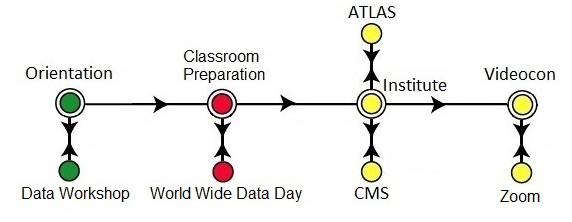
Prior knowledge for masterclasses / Classroom prep objectives
Note: When working with students online, it is still best to lead them to do preparatory activities. Several of these activities have links to notes on virtual adaptation; others may be adapted by the teacher.
Meeting these objectives will assure that students are well prepared for the masterclass.
- Describe the claim and indirect evidence in Rutherford's or another key experiment.
- Identify the peak in a histogram and explain what it means.
- Describe how quarks combine to form mesons and baryons.
- Apply conservation rules to measurements to provide evidence for unobserved particles.
Suggested activities
Particle physics research requires the use of indirect evidence to support claims.
Rolling with Rutherford (virtual adaptation)
Students will be able to:
- Describe the claim and indirect evidence in Rutherford’s experiment.
- Identify the peak in a histogram and explain what it means.
The Standard Model is the current theoretical framework for our understanding of matter.
Choose one or both:
Students will be able to:
- Describe how quarks combine to form mesons and baryons.
- Explain how fundamental particles relate to each other based on their characteristics.
The behavior of particles is governed by conservation laws and mass-energy conversion.
Choose one or both:
Students will be able to:
- Apply conservation rules to measurements to provide evidence for unobserved particles.
Additional resources
- A Day with Particles ← international award-winning video by IPPOG member Voytech Pleskot!
- ATLAS Masterclass website
- CMS videos
- ATLAS videos
- The Particle Adventure
- Bubble Chamber Activity
- Hands-on CERN
Get the word out about International Masterclasses!
 | IMC Poster (PDF) - plain
| 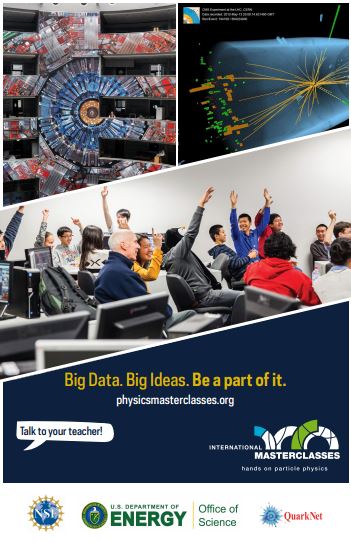 | IMC Poster (PDF) - U.S. logos
|
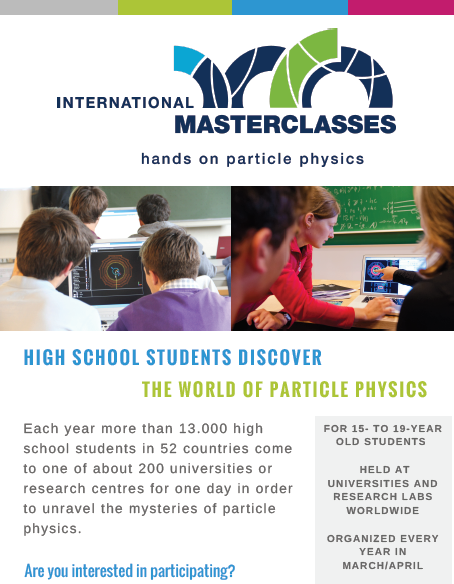 | IMC Flyer (PDF) | 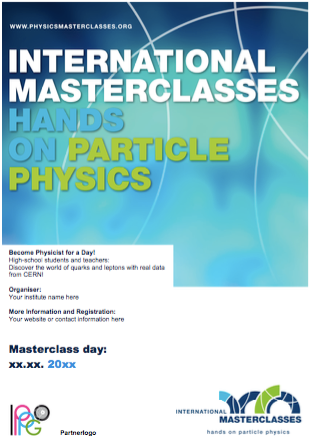 | IMC Poster (doc) - editable |
NuClassroom
Prior knowledge for masterclasses / Classroom prep objectives
Meeting these objectives will assure that students are well prepared for the masterclass. Obectives for MINERvA have labels M1-M3, objectives for MicroBooNE have B1 and B2, and general objectives for neutrino masterclass preparation have labels N1-N3.
| Needed for MINERvA | Needed for NOvA |
|---|---|
|
|
Suggested activities
Students preparing for Neutrino masterclasses should do 3 or more of the following activities most closely aligned with the preparation objectives for the masterclass they will do. The table below gives activities aligned with masterclasses and preparation objectives (in parentheses).
| MINERvA | MicroBooNE |
|---|---|
Note: When working with students online, it is still best to lead them in several of these activities. Several have links to notes for virtual adaptation; others may be adapted by the teacher.
Additional resources
- Videos by Don Lincoln:
- Fermilab All Things Neutrino
- Fermilab MINERvA pages
- Neutrino Classroom
- The Particle Adventure
- Bubble Chamber Activity
Get the word out about International Masterclasses!
 | IMC Poster (PDF) - plain
|  | IMC Poster (PDF) - U.S. logos
|
 | IMC Flyer (PDF) |  | IMC Poster (doc) - editable |
Orientation
This page is to help to guide mentors in preparing their teams, including teachers, for the masterclass.
New Institutes: Masterclass Orientation
A masterclass orientation can be done online via Zoom or in person with a visit from a QuarkNet staff member or fellow. It is intended for teachers and mentors. Here is what is covered:
- Classroom prep for the masterclass
- Try out an ATLAS or CMS masterclass measurement
- Walk-through of masterclass logistics
- Masterclass Library
- Zoom test
- Q&A
This generally takes 3-6 hours, though it can be trimmed or extended depending on needed. If you are doing a CMS or ATLAS Data Workshop in the masterclass orientation period, it counts as an orientation. If you had one previous to this, you only need an orientation update (below).
Register for Masterclass Orientation on the Google form at least one week prior to your earliest preferred date!
Experienced Institutes: Orientation Updates
An orientation update is to bring teachers and mentors up to speed on the latest in masterclass measurements and procedures. As orientation updates are done online, they also serve as Zoom tests. Orientation updates take 1-2 hours.
Register for Masterclass Orientation on the Google form at least one week prior to your earliest preferred date!
Orientation Schedule 2024
Start time in CT and facilitator in parentheses. New registrants: we can accommodate days and times not yet shown on this schedule. Zoom channel links will be provided directly to participants.
| Date 2024 | ATLAS Orientation | CMS Orientation | ATLAS Update | CMS Update | Zoom Test |
|---|---|---|---|---|---|
| Wed 31 Jan | Londrina (08:45) | ||||
| Sat 03 Feb | Berkeley (12:00) | ||||
| Sat 10 Feb | Manhattan, KS (13:00) | ||||
| Sat 17 Feb | |||||
| Fri 23 Feb | NotreDame/StJoe (06:15) | ||||
| Sat 24 Feb | |||||
| Tue 27 Feb | Osorio (12:00) - tentative |
* Site visit.
NuOrientation
Masterclass Orientation
If your instituion is new to masterclasses or to the flavor of masterclass you intend pursue, a full orientation is in order. A masterclass orienation can be done online via Zoom or in person with a visit from a QuarkNet staff member or fellow. It is intended for teachers and mentors. Here is what is covered:
- Classroom prep for the masterclass
- Try out a MINERvA or NOvA masterclass measurement
- Walk-through of masterclass logistics
- Masterclass Library
- Zoom test
- Q&A
This generally takes 1-3 hours, though it can be trimmed or extended depending on need. If you have had a MINERvA Data Workshop in the past year, it counts as an orientation. If you had one previous to this, you may still need an orientation update, which generally takes one hour..
Institutions in NOvA masterclasses need a full orientation as this is a new measurement.
Experienced Institutes: Orientation Updates
An orientation update is to bring teachers and mentors up to speed on the latest in masterclass measurements and procedures. As orientation updates are done online, they also serve as Zoom tests. Orientation updates take 1-2 hours.
Orientation Schedule 2024
Start time in CT and facilitator in parentheses. Nota bene: we can accommodate days and times not yet shown on this schedule.
| Date 2024 | MINERvA Orientation | NOvA Orientation | Zoom Link: | Notes/Remarks |
|---|---|---|---|---|
| Mon 19 Feb | Durham - 8:00 CST (Wood, Pasero) | MINERvA Zoom link | ||
| Wed 21 Feb | Buffalo, Curitiba, Fort Collins - 16:00 CST (Wood, Pasero) | NOvA Zoom Link | ||
| Sat 24 Feb | Puerto Colombia - 09:00 CST (Wood) | NOvA Zoom Link | ||
| Mon 26 Feb | Irvine - 17:00 CST (Wood) | MINERvA Zoom link | ||
| Sat 2 Mar | Mayaguez* (Sedita) | |||
| Practice Sheet | ||||
* Site visit.
ATLAS
This page is to help to guide mentors and teachers in planning the masterclass with the ATLAS Z-path measurement.
Navigation
Need more prep? Try our Instructional Screencasts!
First things: Hypatia and the data
Each computer should have the latest version of the Hypatia program ready to run and at least one dataset of 50 events.
Download:
- Hypatia 7.4← If the zip file does not download, copy the URL and run from a different window.
These must be uncompressed and placed in an easy-to-find folder in each machine.
Grab the data:
Each number corresponds to a group of datasets which should be enough for an entire institute. Each institute is assigned two of these, a primary group and a backup group in case of a large number of students; they are listed in the table below in that order. Within each numbered data group are datasets of 50 events, labelled by letters, A-T. Find your institute and download one set to each computer. You do not need to uncompress these.
| Data assignments for CERN masterclass institutes | ||||||
Table of data assignments for Fermilab 2024 masterclass institutes. | ||||||
| Date | Institute, data groups | Institute, data groups | Institute, data groups | Institute, data groups | Institute, data groups | |
| Mon 04 Mar | Stillwater A, 1 and 2 | |||||
| Fri 08 Mar | Ruston A, 3 and 4 | Stillwater B, 5 and 6 | ||||
| Sat 09 Mar | Santa Cruz, 7 and 8 | Stillwater C, 9 and 10 | ||||
| Tue 12 Mar | DeKalb, 11 and 12 | |||||
| Fri 15 Mar | Ruston B, 13 and 14 | Stillwater D, 10 and 11 | ||||
| Sat 16 Mar | DurhamNC, 1 and 2 | Stillwater E, 3 and 4 | Turlock, 5 and 6 | |||
| Sat 27 Apr | Berkeley, 1 and 2 | VancouverTRIUMF, 3 and 4 | Burnaby, 5 and 6 | Victoria, 7 and 8 | FallsChurch, 9 | |
| Fri 28 Jun | Upton, 1 | |||||
E-mail for data login and password.
Familiarize yourself:
Share these with students when appropriate!
Students arrive
This should occupy the first 30-60 min:
- Registration: please have students sign in on a registration sheet with name, school, and teacher.
- Gateway experience: have a cloud chamber, e/m apparatus, or something similar to whet interest
- Ice-breaker activity: students in small inhomogeneous groups create 1-2 good questions about particle physics, ATLAS, and/or LHC.
Shift training
Get students ready for their data analysis shift! This will take about 3 hours, though parts of it can be moved to other times of the day.
Mentor presentation, 30-60 min:
- keep it interactive - ask questions about prior experience, shows of hands, wild guesses, etc.
- give students something to touch, e.g. a carbon-fiber straw from TRT
- connect to classroom prep
- touch on standard model
- talk about your research
- template
Tour, 30-60 min:
- adds much to the day - often most popular part
- if you have an accelerator to show, great!
- if not: any interesting labs, even if not particle physics, are still great
- have enthusiastic grad students around to chat and explain
Analysis Prep (30-60 min):
- Have a teacher lead this if practical
- Use/adapt the data analysis slides (PPT) (PDF).
- Important: go through 5-10 events from Group 1 Set A on the projector with the students. Show them how to:
- Turn on Hypatia
- Get the data
- Set the pt cut
- Put tracks into the invariant mass window
- Save their data and upload to OPloT. (Show the 01-Jan-2012 sample.)
- Identify events with them - ask them what is what.
Lunch with a Physicist (30-60 min):
- This is also very popular and a great way for students to interact and get comfortable with scientists.
Data analysis
This is the heart of the masterclass and takes 60-90 min. There should be 2 students at each computer, cooperating to get their data measured. Mentors, tutors, and teachers should circulate to help the students analyze the events and work out any problems they have. Don't give them answers. Help them figure things out and learn to see data as scientist does. Remind them that each event is a candidate Z, Higgs, or something else - not a definitively identified particle.
Here are some items that can help them (and you):
- Data Tally Sheet
- Cheat sheet (short) (long)
- ATLAS Event Guide
- ATLAS Analysis Procedure
Students will need to upload to OPlot. Help them with this.
Sharing results
This takes a little over one hour. Both parts are important.
Discussion (30-45 min):
- Mentor leads, students interact
- Look at combined mass plots for your institute in OPloT: dilepton, 4-lepton, diphoton
- Help students point out peaks, bumps, significance; discuss results.
- Each institute is assigned another institute to question: look at their data as well. Students should form questions and comments.
Videoconference (30-45 min):
- FNAL institutes connect to Indico page (see table above)
- CERN institutes connect using special links CERN-VC1 and CERN-VC2; consult schedule for which to use.
- Someone should log into the videoconference 15 min early to be sure the connection is established. See the Schedules page.
- Follow the agenda on Indico:
- Introductions and warm-up
- Institute results
- Combined results
- Discussion, Q&A, and wrap-up
- It is good to have a student spokesperson but try to arrange so it is not too hard for another student to make a comment or ask a question.
After this, we have post-discussion and closeout.
Before you go home:
Please report your attendance numbers on our Attendance Form!
Have a great day!
CMS
This page is to help to guide mentors and teachers in planning the masterclass with the CMS WZH-path measurement..
Navigation
Need more prep? Try our Instructional Screencasts!
First things: iSPy and spreadsheets
Each computer should have robust internet access (preferred) or the DVD version of the masterclass loaded. Two students should work together at each computer to complete 100 events of the 10 000-event sample.
Online:
- Students must have access to the event display program iSpy-webgl using the latest version of Chrome, Edge, Firefox, or Safari.
- Students must have access to the online spreadsheet. These will be linked from the schedule of CMS videoconferences under Data Analysis below.
- Students should have access to the CMS Masterclass website prior to the masterclass day.
Download versions:
See documentation, below.
Grab the data:
See Data Analysis, below.
Familiarize yourself:
Please note that introduction of the new CIMA data tool means key procedures have changed. It is important for mentors to and teachers review the documentation and try it out in the CIMA Sandbox.
- CMS Masterclass screencasts
- CMS Masterclass documentation (2024 version)
- CMS Masterlass website
- Try the measurement out with advanced iSpy and CIMA (use Sandbox-31Dec2023) or the Google Sheet Sandbox.
Share these with students when appropriate!
Students arrive
This should occupy the first 30-60 min
- Registration: please have students sign in on a registration sheet with name, school, and teacher.
- Gateway experience: have a cloud chamber, e/m apparatus, or something similar to whet interest
- Ice-breaker activity: students in small heterogeneous groups create 1-2 good questions about particle physics, ATLAS, and/or LHC.
Shift training
Get students ready for their data analysis shift! This will take about 3 hours, though parts of it can be moved to other times of the day.
Mentor presentation, 30-60 min:
- keep it interactive - ask questions about prior experience, shows of hands, wild guesses, etc.
- give students something to touch, e.g. a wave-shifting fiber
- connect to classroom prep
- touch on standard model
- talk about your research
- template
Tour, 30-60 min:
- adds much to the day - often most popular part
- if you have an accelerator to show, great!
- if not: any interesting labs, even if not particle physics, are still great
- have enthusiastic grad students around to chat and explain
Analysis Prep (30-60 min):
- Have a teacher lead this if practical.
- Use/adapt the data analysis slides (PPT) (PDF).
- Important: go through "masterclass-samples" in iSpy-online on the projector with the students:
- Show students how to navigate to a data file
- Discuss how to use the tools in iSpy-online (or iSpy-dvd)
- Discuss each event in terms of:
- Particle tracks, missing energy, ECal deposits, etc.
- Most likely parent particle (ask them what is what)
- Show how to record results on sample spreadsheet.
Lunch with a Physicist (30-60 min):
- This is also very popular and a great way for students to interact and get comfortable with scientists.
Data Analysis
This is the heart of the masterclass and takes 60-90 min. There should be 2 students at each computer, cooperating to get their data measured. Mentors, tutors, and teachers should circulate to help the students analyze the events and work out any problems they have. Don't give them answers. Help them figure things out and learn to see data as scientist does. Remind them that each event is a candidate Z, W, Higgs, or something else - not a definitively identified particle.
Note: Google spreadsheets have been phased out in favor of CIMA. If there are special cicumstances, contact Ken Cecire for an exception.
Sharing Results
This takes a little over one hour. Both parts are important.
Discussion (30-45 min):
- Mentor leads, students interact
- Look at combined mass plots for your institute in spreadsheet.
- Help students point out peaks, bumps, significance; discuss results.
- Each institute is assigned another institute to question: look at their data as well. Students should form questions and comments.
Videoconference (30-45 min):
Connecting to videoconferences:
- For CERN-based videoconferences, see the schedule page of the IMC website.
- For Fermilab-based masterclasses, see the schedule on the Videoconferences page.
Course of a videoconference:
- Connect to videoconference link or Indico page (see above).
- Someone should log into the videoconference 15 min early to be sure the connection is established. See the Schedules page.
- Follow the agenda on Indico:
- Introductions and warm-up
- Institute results
- Combined results
- Discussion, Q&A, and wrap-up
- It is good to have a student spokesperson but try to arrange so it is not too hard for another student to make a comment or ask a question.
After this, we have post-discussion and closeout.
Before you go home:
Please report your attendance numbers on our Attendance Form!
Have a great day!
CMS doc
2024 Edition
Short URL for this page: http://cern.ch/go/76BG.
This document in PDF form: CMS_Masterclass_Documentation_21Feb2024.
CMS WZH 2,4-Lepton Measurement
Created by K. Cecire, T. McCauley, QuarkNet LHC fellows
The CMS WZH measurement is supported for International Masterclasses.
Languages supported: Chinese, Dutch, English, French, German, Hebrew, Hungarian, Italian, Japanese, Polish, Portuguese, Russian, Spanish, Turkish
Contents:
- Description
- Requirements for hardware and software
- Outline of the day
- Student procedure
- Presentation of results
- Sample questions
- Moderators
- Short Appendix on the Google Sheets Option
- Students use event display of leptonic decays to determine
- final state: 1 electron plus missing ET, 1 muon plus missing ET, 2 electron, 2 muon, 4 electron, 4 muon, or 2 electron and 2 muon (note that lepton pairs should contain one negative matter lepton and one postive antimatter lepton)
- charges of leptons, especially for one lepton plus missing ET
- primary state: W+, W-, W± (indicating electric charge unknown), neutral particle, zoo
- charge if W, using curvature of electron or muon tracks,
- Students use particle counts to find e:µ and W+:W- ratios.
- Students create mass plots. They find the masses of neutral particle peaks in two mass histograms: 2-lepton and 4-lepton. Histograms are fed automatically upon entry of masses.
- Students use the iSpy-webgl event display and the CMS Instrument for Masterclass Analysis (CIMA). Instructional screencasts are available. In addition, we are piloting a Google Sheet option as a substitute for CIMA.
Dataset: There are 190 .ig data files in the iSpy event display. Each file contains 100 events. These files are made up varying mixtures from 10,000 1 and 2 lepton events and about 300 4-lepton events in varying mixtures, They are divided into data groups: N5, N10, N25, N50, and N100. The number after N refers to how many data files are in that data group. The ~300 4-lepton events are distributed equally in each group. Thus in group N5, each file has about 300/5 = 60 evetns with 4 leptons and 40 of everything else. In group N100, each file has about 3 events with 4 leptons and 97 events of other kinds. This is to accommodate masterclasses with different numbers of students.
Requirements
for hardware and software.
Online:
- Reliable, high-speed internet connection
- Up-to-date version of Firefox, Chrome, Edge, or Safari. Other browsers are also likely ro work but please check them before you rely on them.
Offline:
- Not recommended. If you must work offline, contact CMS masterclass coordination.
Outline of the day
This is not a final schedule but an outline for most U.S. institutes.
- Arrival/Registration (~30 min)
- Cloud chamber, e/m apparatus, or other "gateway experience" apparatus setup for students to inspect
- Start and Ice-breaker activity (~30 min)
- Students in small groups create 1-2 good questions about particle physics and/or LHC. Where practical, groups should be made of students from different schools.
- Mentor presentation
- Template (~60 min, including Q&A)
- Tour of facilities/labs/cool stuff (~45 min)
- Analysis preparation (1-2 teachers facilitate; ~60 min, including Q&A)
- Presentation (template)
- Data analysis slides
- Guided practice with discussion
- Lunch with a physicist (~60 min)
- Data Analysis (~90 min)
- Pre-conference (~30 min)
- Students and mentor discuss meaning of analysis results.
- Students and mentor discuss questions for other institutes.
- Revisit questions from ice-breaker, discuss which to ask in video conference.
- Designated IT expert preps video connection.
- Videoconference (~30 min)
- Greetings
- Presentation of results
- Discussion of results
- Q&A
- Summing up and evaluation (~15 min)
Student tasks:
- Each pair of students analyzes a set of 100 events
- For each event, distinguish between electron and muon decay and between
- W+ or W- candidate (recorded as "W±" if charge cannot be determined),
- Neutral Particle (Z, H or other "neutral particle" candidate),
- and zoo event (unusual and cannot be characterized).
- Record into CIMA or, Google Sheet alternative.
- Be prepared to discuss in Masterclass Institute and in videoconference; prepare good questions.
Student procedure
It is important to carefully note the following:
- Mentors and tutors need to be familiar with CIMA or the Google Sheet in order to guide the students successfully.
- The description below is for the current versions of the iSpy event display (iSpy-webgl) and the CMS Instrument for Masterclass Analysis (CIMA) used for the CMS WZH 2,4-lepton masterclass. This is the primary version used in International Masterclasses. There is an appendix for the use of the Google Sheets.
- The legacy iSpy-online is still recommended for the J/Psi-path masterclass. This is described on the CMS masterclass website J/Psi-path page.
Mentors should guide students to follow these procedures for the use of iSpy and CIMA:
Screencast: https://web.quarknet.org/mc/videos/CMSanalysis_20feb2024.mp4.
- Pairs of students are assigned sets of 100 events to analyze in iSpy-webgl.
- Event sets are found in iSpy-webgl by choosing the folder icon (top left).
- A first window appears. If the data is to be taken from the internet, choose "Open file(s) from web" in this window. A second window will open.
- In the second window, students first choose their data group - N5, N10, N25, N50, or N100 according to their assignment. After choosing a group, they will see a set of data files labeled masterclass_n.ig, where n is the number of the data file. For N5, n = 1, 2, ..., 5; for N10, n = 1, 2, ..., 10, etc. The entire set of 100 events will then load into the browser. This may take a little time but going from event to event is rapid after that.
- After the set of 100 events is loaded, a list of events in that set will appear on the left side of the window. The student chooses the first of these events and then the "Load" button. This will open the first event.
- Students also open CIMA and then find their masterclass by date ("Choose your Masterclass") and then institute ("Choose your location"). They then choose the number of their event set ("Choose your file"): this is the same number as the event set in iSpy-webgl but rendered a N.n, That is, group N25, file 6 is rendered as 25.6.
- Notes on CIMA for students:
- CIMA will have your date and your institute from to choose.
- CIMA automatically populates the mass histograms.
- CIMA is also linked at the CMS Library page (scroll down to Data Analysis).
Find the correct data files in iSpy and CIMA:
After iSpy is open, go the the file folder and, when the pop-up box appears, choose "Open files from web",

Then choose the assigned data group (N5, N10, ...). A list of data files will appear. Choose the assigned file. Then choose the first event and the Load button.

The first event will appear.

Use he right (left) arrow button (1) to go to the next (previous) event. That comes when we finish this event. We can use the magnifying glass buttons (2) to zoom in or out. Let's set our image to the Y-X (end) view by choosing the Y-X button (3). Choose Tracking (4) to take care of the multiplicity of yellow low-energy tracks (5).This is the result of going to Y-X, zooming in, and choosing Tracking>Tracks>Tracks (reco.):
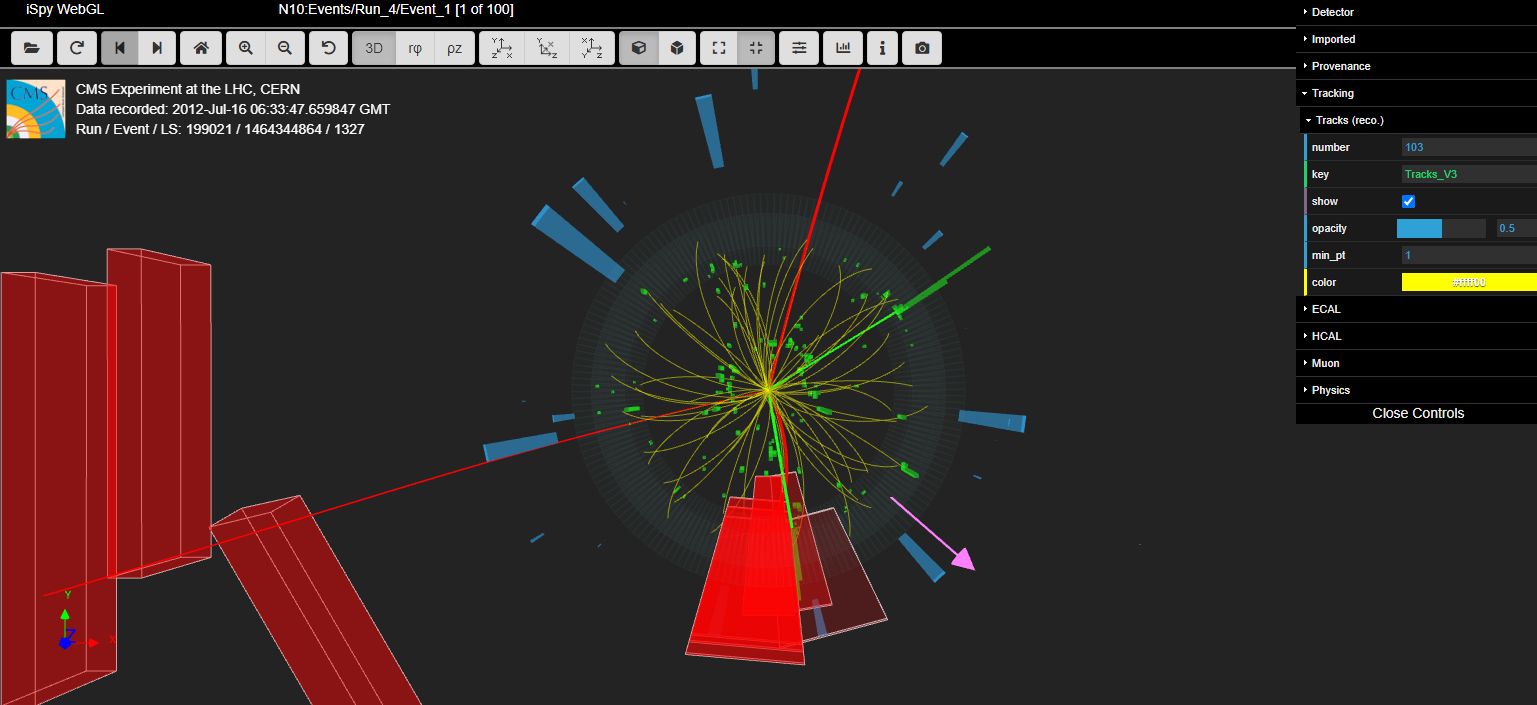
This display shows the final state of the event. The longer red tracks are muon tracks as identified by the analysis software. Note the red boxes: they are muon chambers intersected by the muons. The shorter green tracks are electrons. One can see by the opposite curvatures of the tracks in each pair in the Y-X plane (transverse to the beamline and to the magnetic field) that the pairs are made up of two particles of opposite electrical charge. In these renderings, a clockwise curvature indicates positive change and an anti-clockwise curvature indicates negative charge.
The two muons and two electrons may have come from a primary state particle. To find its mass, we can move our mouse until one track turns gray, click, move again until the second track turns gray, and click again. Note that we have gotten rid of the yellow low-energy tracks by unchecking "show" under Tracks (reco.) to the right. This is what we get:
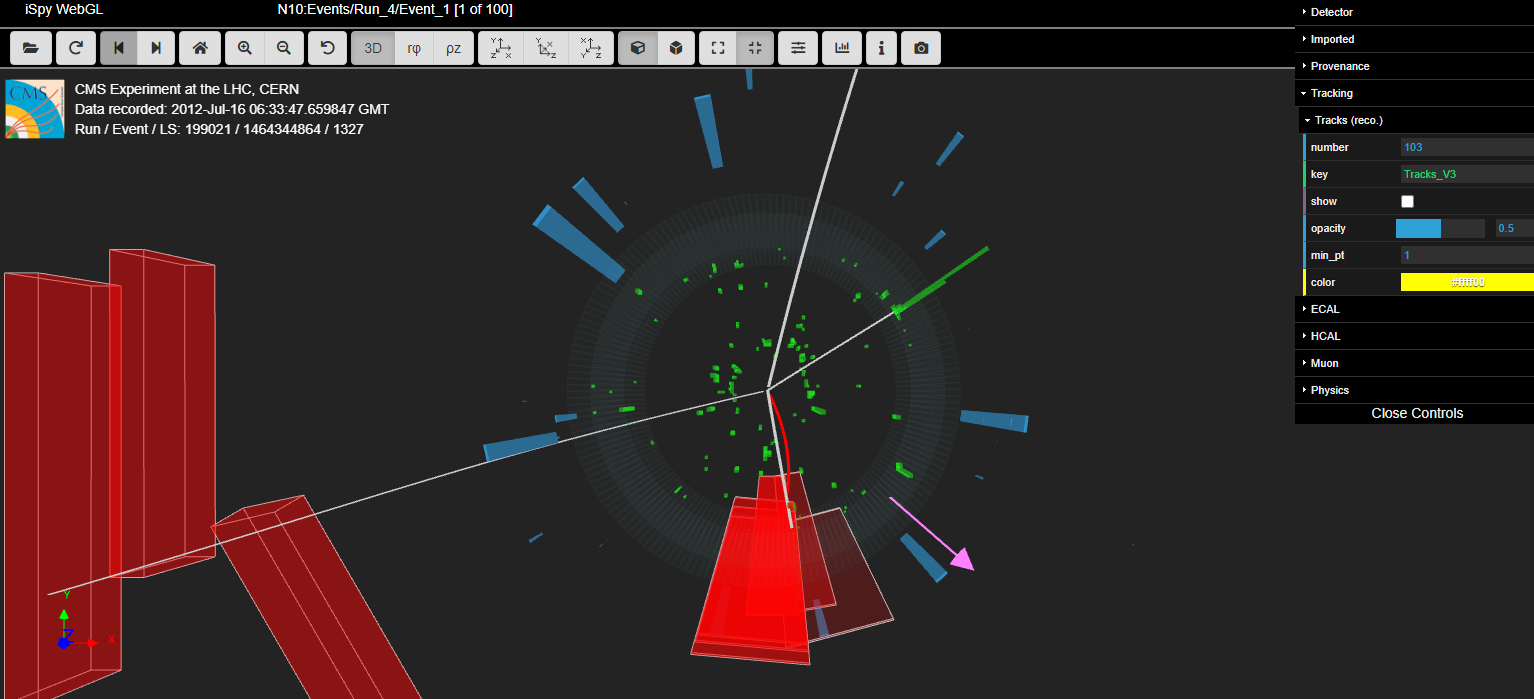
We then press m on the keyboard and the mass of the primary state particle appears:
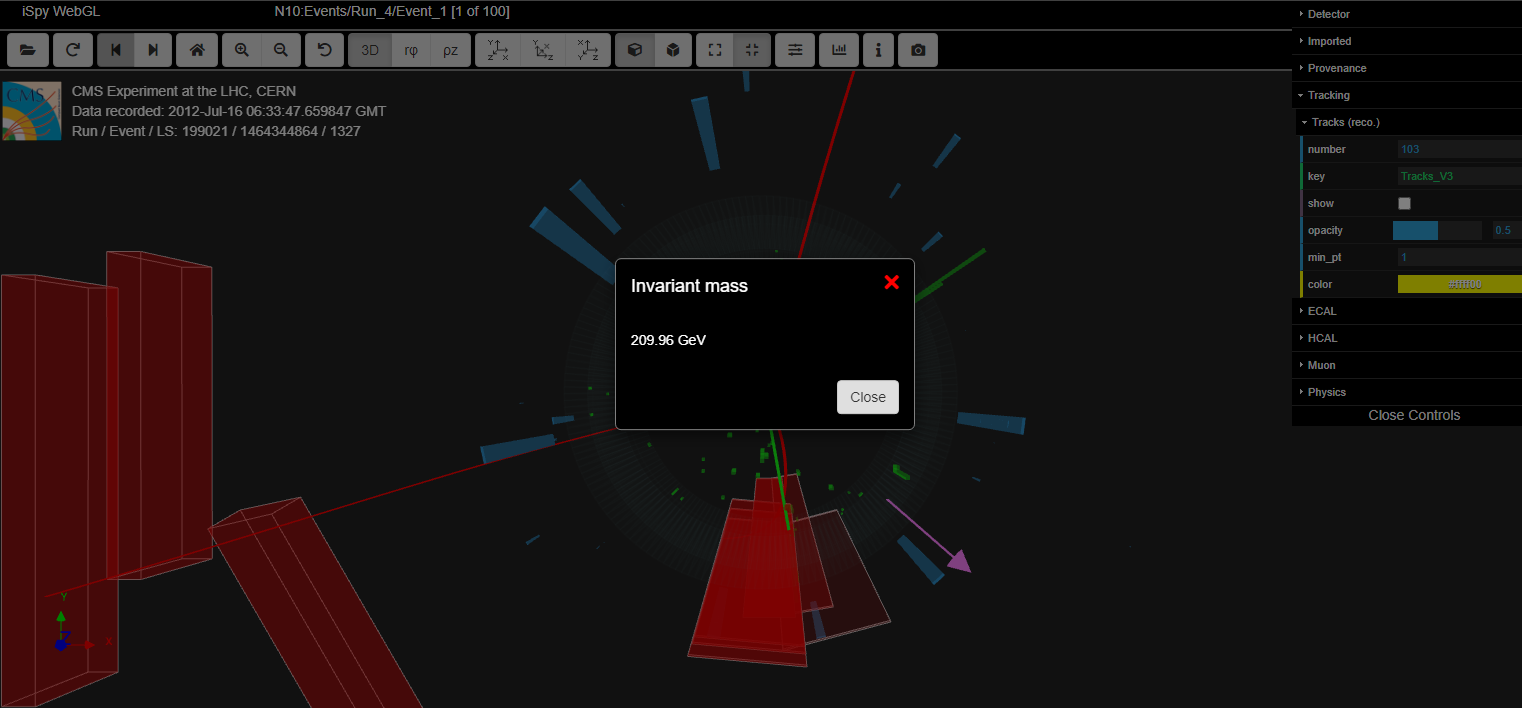
Note that the tracks are reset to their original colors once the mass appears.
What we do with this data is what goes in CIMA. Here it is:
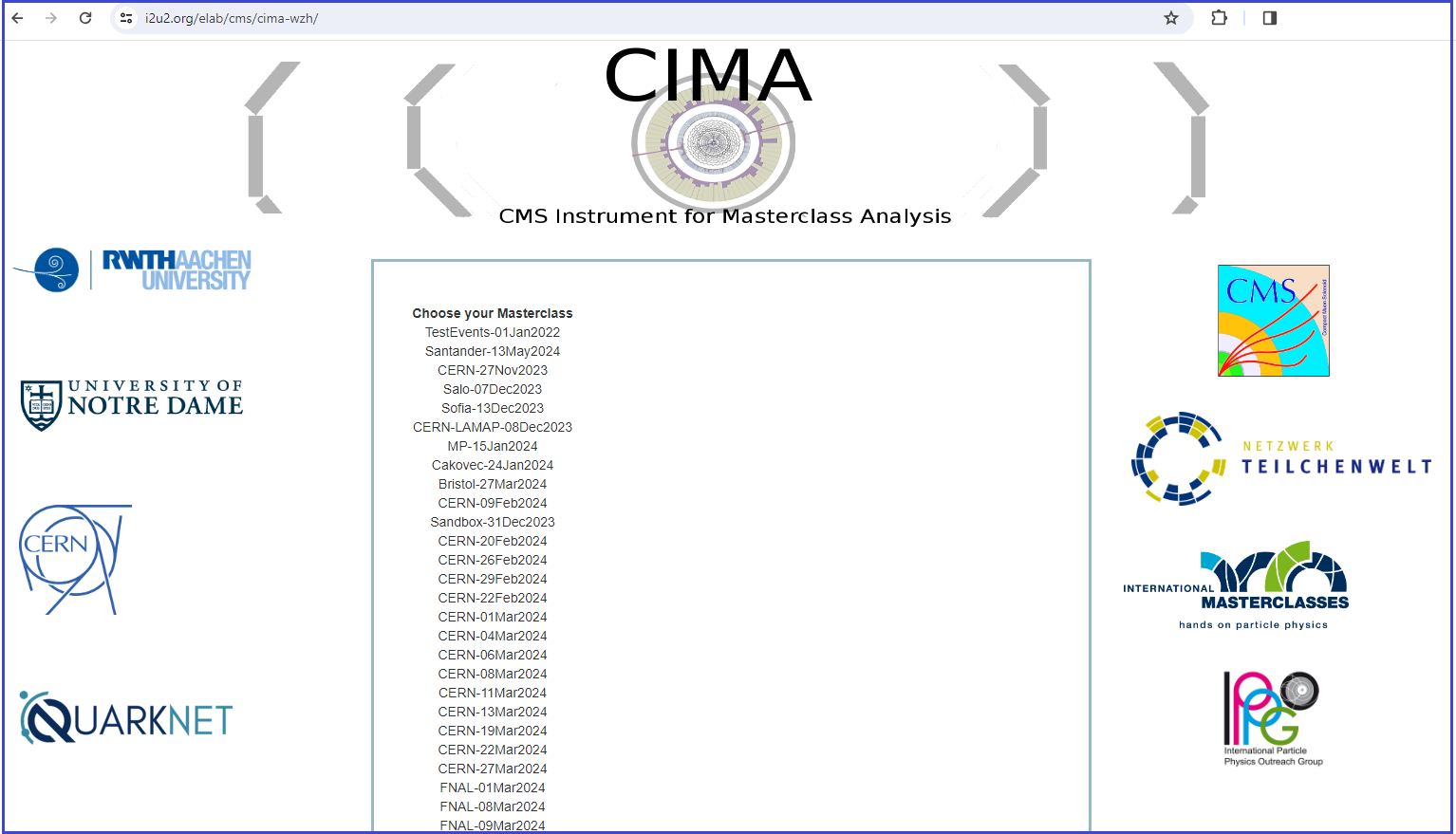
We now choose our masterclass, location, and data file (10.4, same as we saw in iSpy above).
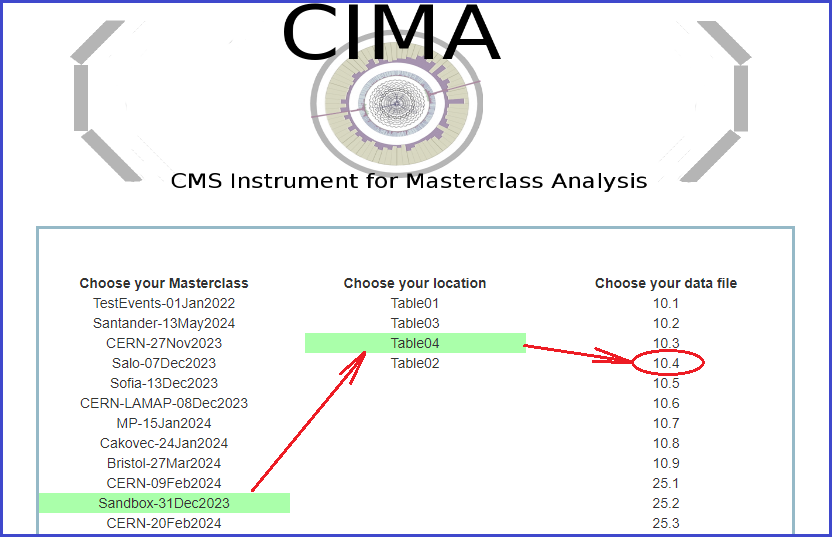
When we open data file 10.4, we see we are exactly where we should start: The Event index under Select Event is 1. All else is blank for us to fill. Since we had two muons and two electrons in the event, we choose 2e 2μ under Final State. The event has net charge 0 so the parent particle that transformed into the four daughter particles is neutral. We choose Neutral Particle under Primary State. That enables Enter Mass, where we type in our 209.96 from iSpy-webgl:
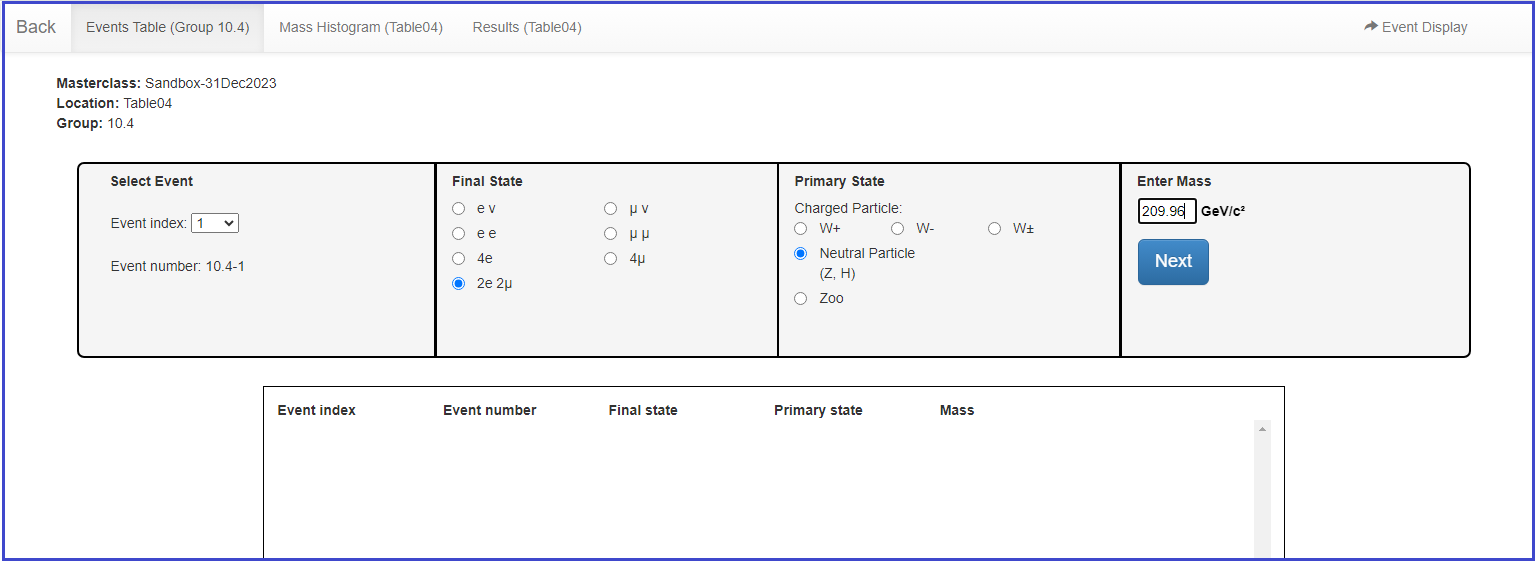
When we choose the Next button, the results are recorded for 10.4-1:
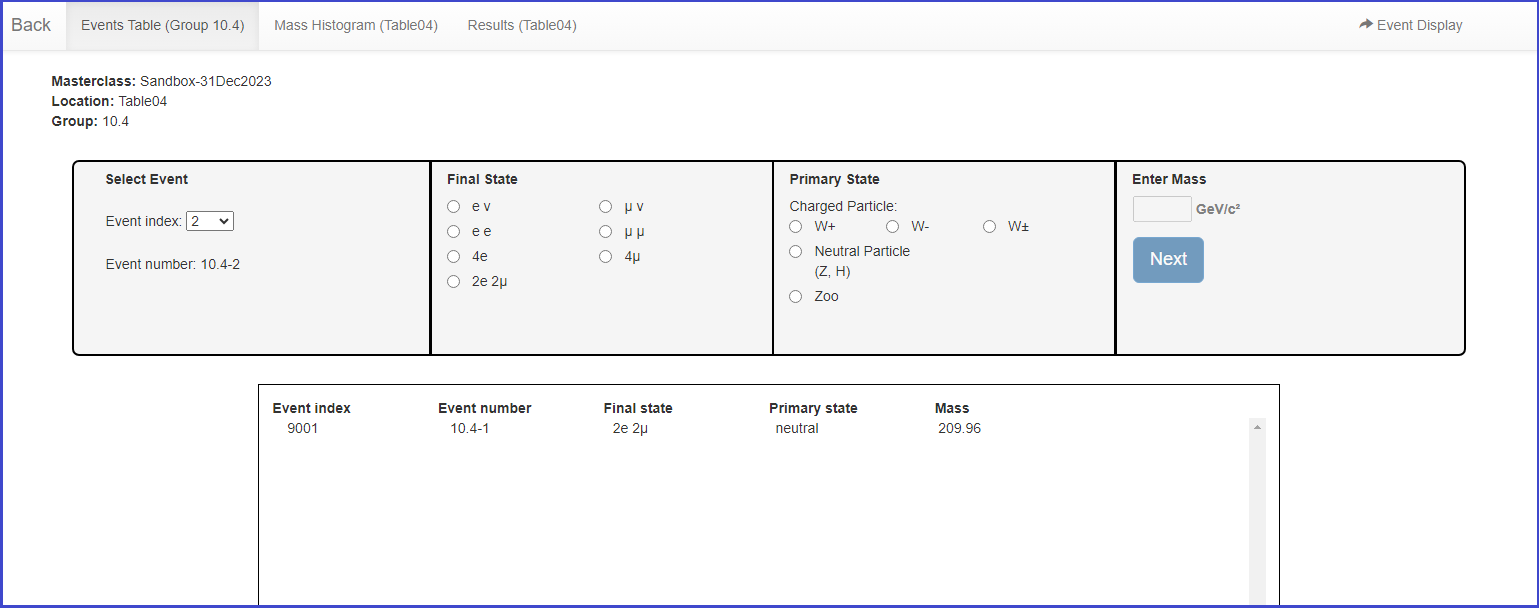
We return to iSpy and advance to the next event and the next, recording results in CIMA as we go. At 10.4-4, for example, we have a single-muon plus missing ET event:
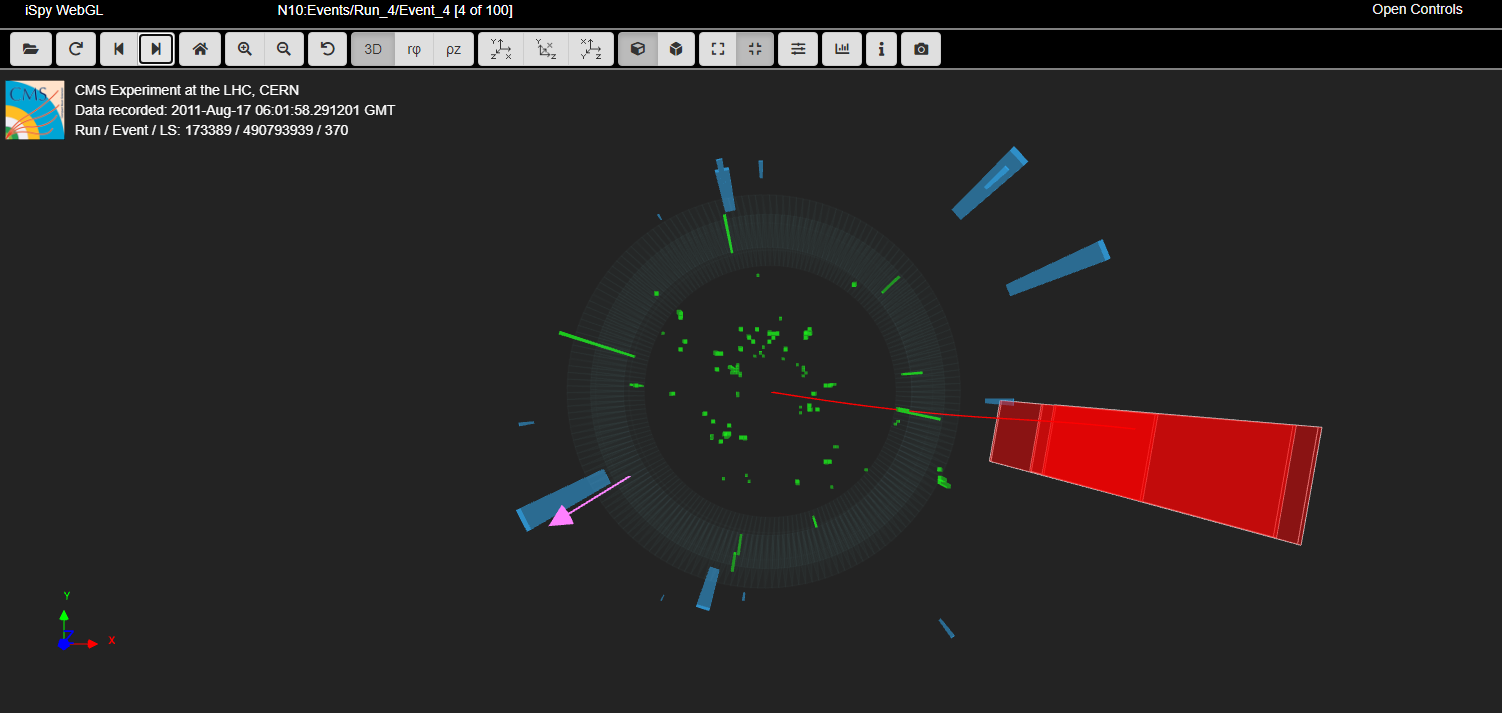
Note that we have closed the Controls window. It can be re-opened by choosing Open Controls at the top right.
The purple or pink arrow is indicative of missing ET, presumably a neutrino. The muon is positive if its curvature in the magnetic field is clockwise or negative if its curvature is anti-clockwise. (Note: To show the proper curvature, we must use the Y-X view as its plane is transverse to the magnetic field.) To be able to tell as accurately as we can, we choose Settings (circled here) and then, from the pop-up, we check "Show track curvature guide" and then close the pop-up. Now we can see that the muon is negative:
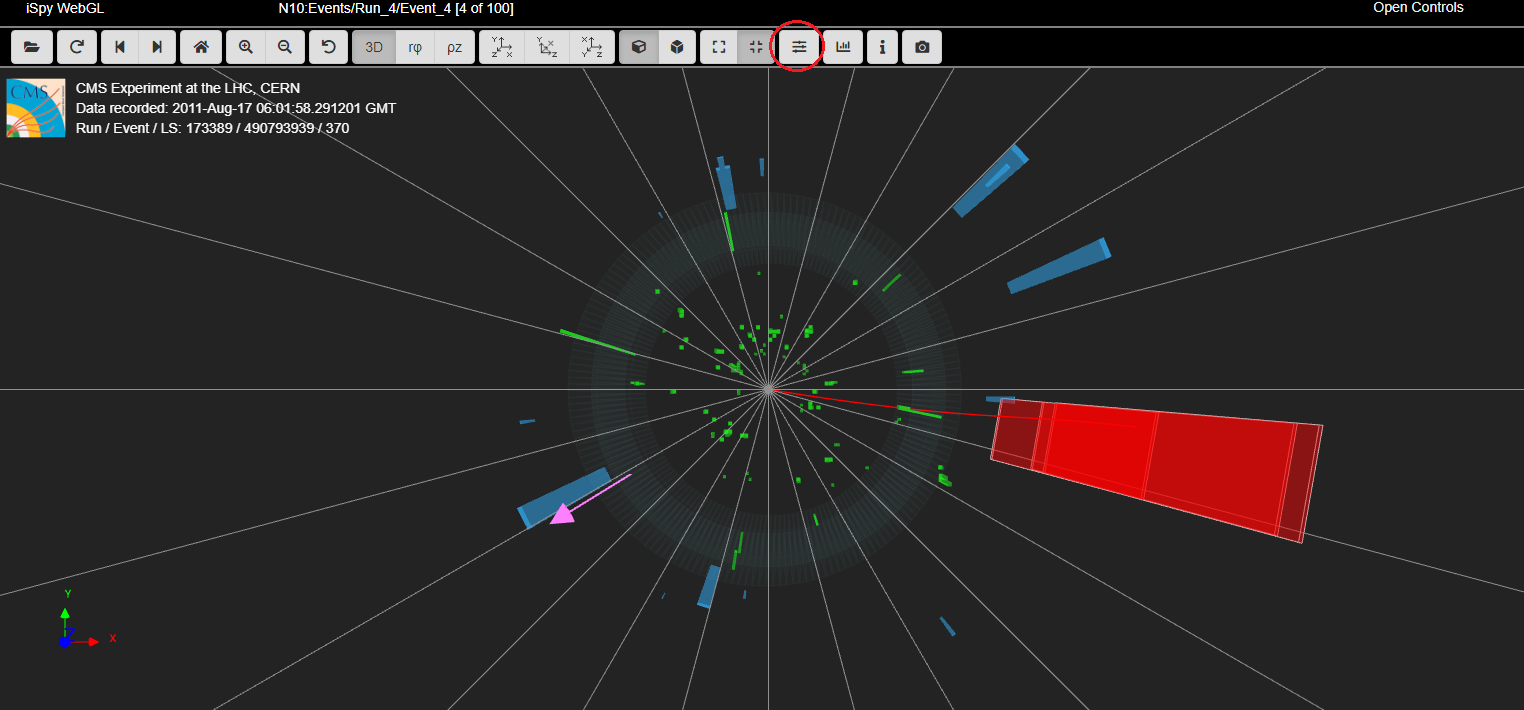
Since the presumed neutrino is neutral, the parent particle must also be negative. Thus we this this is a W- candidate event, in which the W- decayed into a muon and a muon anti-neutrino. We can record this in CIMA as μν for the Final State and W- for the Initial State. We do not try to find or record a mass for any W candidate. CMS can only find the transverse mass of a W candidate and these cannot mix into our mass histograms in any meaningful way. Here is the result after we choose the Next button:
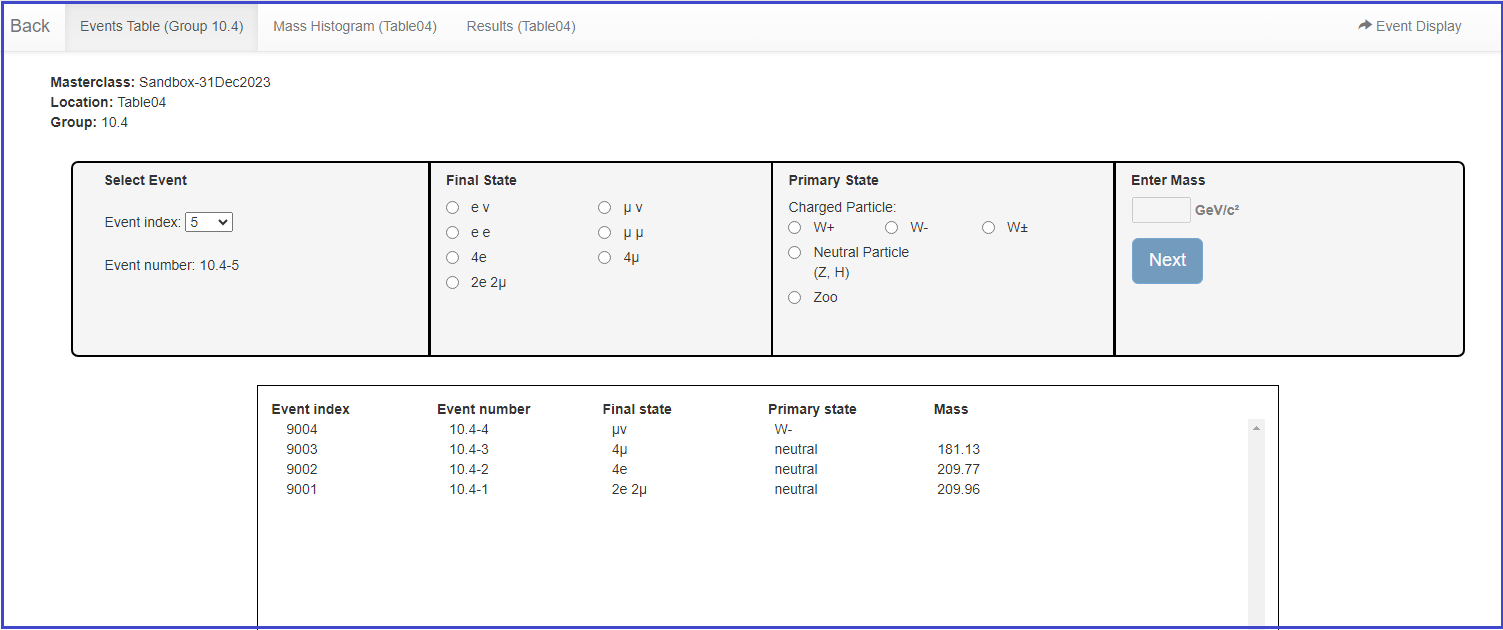
Students continue on to analyze as many of their 100 assigned events as time and care allow.
Between what was entered above, previous work, ad a little more analysis, there is enough in our "Sandbox" to look at the other tabs in CIMA. Here are the histograms we have so far:

This is not much to look at yet but a whole class of students, with every 2 taking on a 100-event data file, can populate it a bit more.
Here is our Results tab:
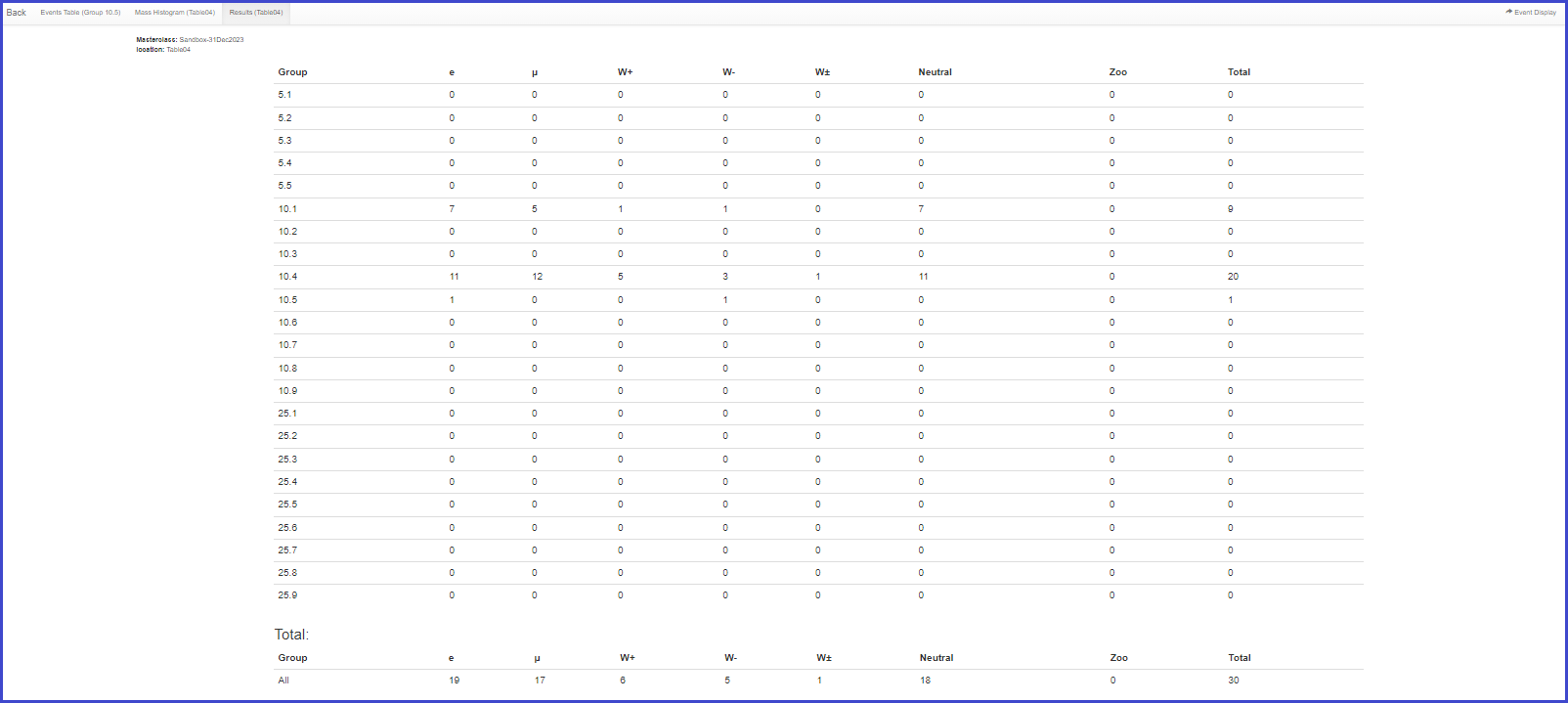
Note the total numbers of electrons, muons, W+, and W- under Total at the bottom. Students should calculate from these the e:μ and W+:W- ratios. Our expectations, with sufficient statistics, are e/μ = 1 and W+/W- = 1.4 but results will vary quite a lot.
In summary, students use event display of (mostly) leptonic decays to determine
- Final state lepton ID (electron, muon). This is to characterize the event, not individual particles.
- If the event has one muon track (long, red) and missing ET (purple or pink line) is is a μν event.
- If the event has one electron track (short, green) and missing ET (purple or pink line) is is an eν event.
- If it has two muon tracks (actually likely a muon-antimuon pair) it is a μμ event
- If the event has two electron tracks (actually likely an electron-positron pair) is is an ee event.
- If it has 4 short green electron tracks it is a 4e event.
- If it has 4 long red tracks is is a 4μ event.
- If it has 2 short green and 2 long red tracks it is a 2e2μ event.
- Likely particle ID (final state)
- W candidates are cases 1 and 2 above. The charge of the W boson can usually be determined from the curvature of the visible lepton track in the x-y view: positive for clockwise, negative for anti-clockwise. If the curvature cannot be detected then the final state is W±, meaning we cannot determine the charge.
- Neutral Particles are cases 3-7.
- Cases 3 and 4 are 2-lepton events and their masses should show up in the upper mass histogram.
- Cases 5-7 are in 4-lepton events and their masses should show up in the lower mass histogram.
- Some events will have multiple lepton tracks plus missing Et. The student can choose a track with the cursor (tunring it gray) and a track information will appear in the table below the image in iSpy. The most important of these is transverse momentum, pt. This can be used to distinguish which tracks are important and which are low-energy background.
- Zoo events are "none of the above" but there can be interesting events among these.
Presentation of results
The mass plots and summary of results are automatically built in the institute (location) Mass Histogram and Results pages. The upper (2-lepton) mass plot will show not only a Z peak but also peaks due to other particles. The results will show the numbers of electron, muon, W+, W-, W± (unknown charge), Neutral Particle candidates, and zoo events plus the key ratios e:μ and W+:W-. The mentor or tutor should project the mass plot and the count/ratio results and discuss their signficance with students. The mentor or tutor should also help the students to generate questions for the videoconference or other later discussion.
Sample questions
In discussion, the moderator might ask students
- How many peaks are there in the 2-lepton mass plot?
- Where is the Z peak? What is the mass of the Z boson?
- What do the other peaks mean?
- Is there a Z-peak in the 4-lepton plot? If so, why?
- What else can we see in the 4-lepton plot. Is there evidence of the Higgs boson? What else?
- What is the ratio of electrons to muons? Is it close to what we should expect?
- What is the W+:W- ratio? What should it be?
In the videoconference, students might ask questions like
- Why are the widths or heights or numbers of peaks different from one Institute to the next?
- Why do different Institutes get different ratios? How did they identify electrons or muons or W candidates or Z candidates or zoo events? How did they measure charge for W candidates?
- Now that the Tevatron is shut down, what do you do at Fermilab?
- Is it boring at CERN when the LHC is not running?
- Why did you become a physicist?
...and better questions which only students can create.
Moderators
Fermilab-based moderators should refer to the FNAL Masterclass Moderators page.
All moderators should note the following:
As long as all groups use advanced CIMA, moderators do not need to look for uploads from any of the masterclass institutes or make histograms on their own. There is one "Table" for each masterclass institute (location) participating in a single videconference. Each institute has a Mass Histrogram and a Results page.
- Mass Histograms - students use "Events Tables" to record W or Neutral Particle (J/Ψ, Υ, Z, Zγ, H, ZZ candidates), e or µ events, and "zoo" events.
- The Neutral Particle candidates may show up in the 2-lepton and 4-lpeton mass plots. The plots populate autmatically as students work.
- Results - numbers of different types of particles are automatically transferred here; e:µ and W+:W- are calculated for the whole institute.
The moderators will access the Admin page of CIMA to view these and share them on Vidyo. They will also view and share the combined Mass Histogram and combined Results for all institutes participating in their videoconference.
To get to the appropriate places, moderators only should go to the CIMA Admin page.

Then:
- Log in. The user name and password will be sent separately.
- Please do not touch anything above Manage Tables or the "change active status" or "delete" buttons..
- Go to the part of the page under Masterclasses beneath the Manage Tables heading.
- Choose the appropriate masterclass. Below we choose NCU-TW-05Jan2020.
- We then choose the Results button.
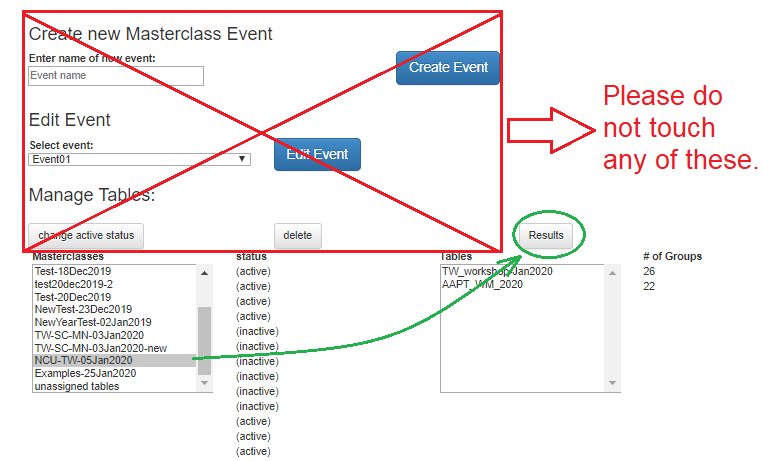
You are now on the Results tab for combined results for all institutes in the videoconference.

In this case, there are only two: TW_workshop_Jan2020 and AAPT_WM_2020. You can then choose the Mass Histogram tab to view the mass plots.
To choose results for a particular institute (and you should do this for each one), use the browswer bakc arrow to back out to the main CIMA admin page. Then choose the overall masterclass and the individual masterclass:
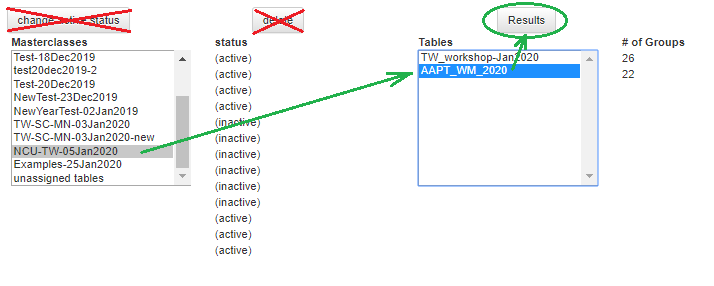
Moderators should discuss the results from each institute and the overall results with the students, making sure to stay within time constraints. If an institute does not use the online spreadsheet, the mentor for that institute should show their mass plot and results using Vidyo desktop sharing. (This may occur due to bandwidth issues or if if a group uses the "classic" WZH 2-lepton masterclass.)
The two mass plots for the combined results are below with annotations. Even with a relatively small number of events, we can see a basic outline with key peaks, though as it turns out the Higgs peak is probably exaggerated in this sample.
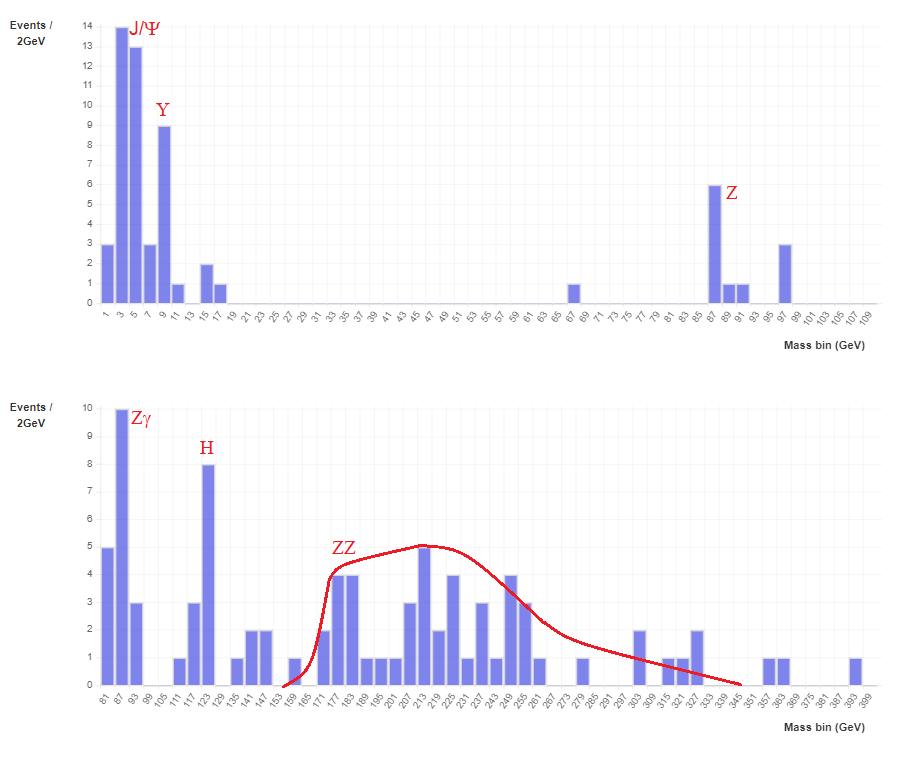
Short Appendix on the Google Sheets Option
If you are assigned a Google Sheet, it is filled out much the same as CIMA in the Student Procedure above, with some caveats.
- There is no Next button to choose. Students check the appropriate boxes and enter masses and the data loads automatically.
- Students find their masterclass in a tab at the bottom of the sheet. They then scroll down to the part of the sheet marked with dataset number, e.g. 10.4, in the leftmost column.
- The plots and and the totals populate on the same page (at the top) as the students work.
- The sheets usually come with a little "dummy" data at the top of the page. This helps to preserve the plots in Sheets. Students assigned to those datasets should overwrite the dummy data.
- Students must be very careful to not overwrite each other's work and to be sure that they are on the correct line as they enter results. in general, they need to exercise a little more care in Sheets than they do in CIMA.
- CIMA lists last event first in the Events Table. The Google Sheets go from the top down.
- The Google Sheets calculate ratios and uncertainties.
- Mass plots can be user adjusted, for example changing bin widths.
Here is the top of the N10 sheet with the same data as in the CIMA example above:
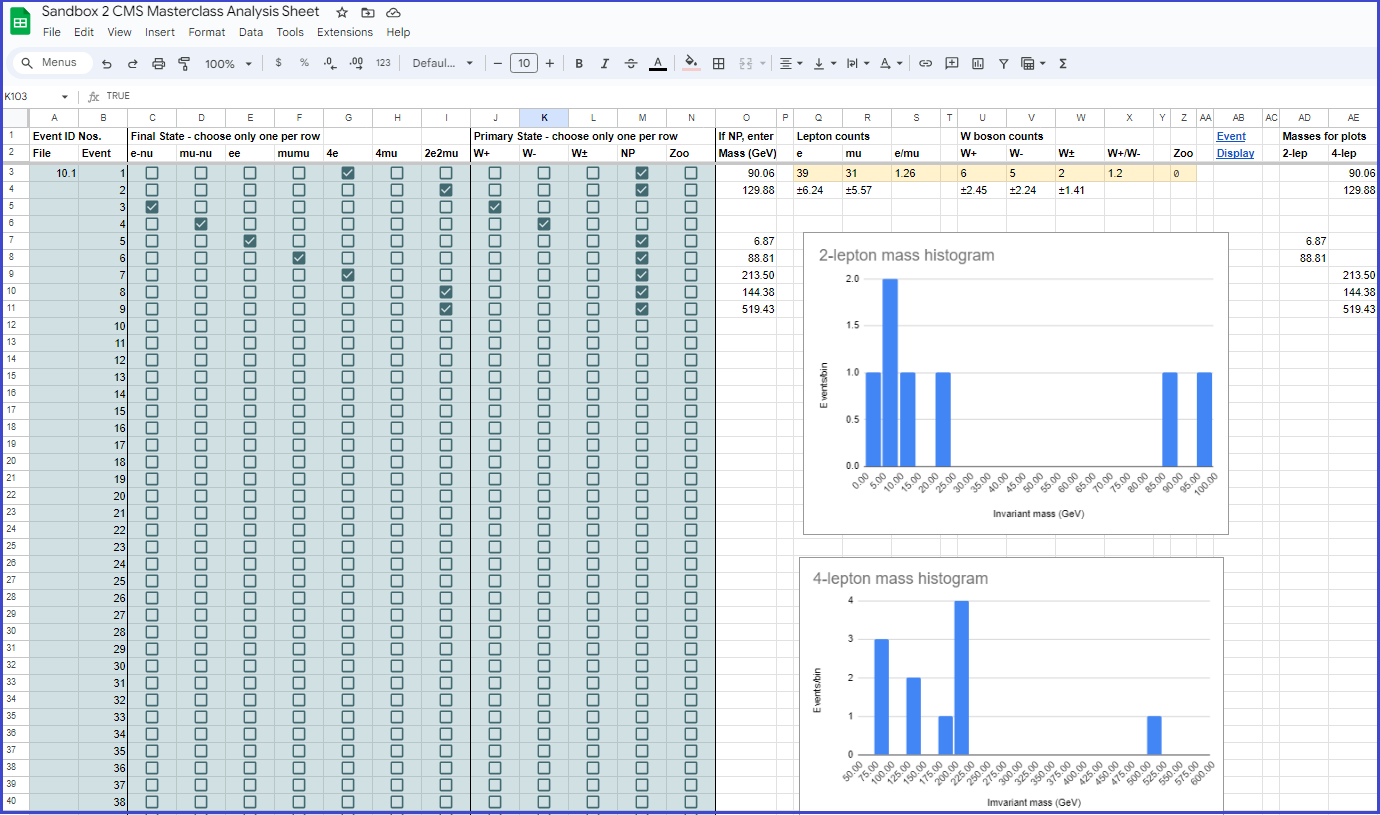
Here is the same data from 10.4 as entered in CIMA above:
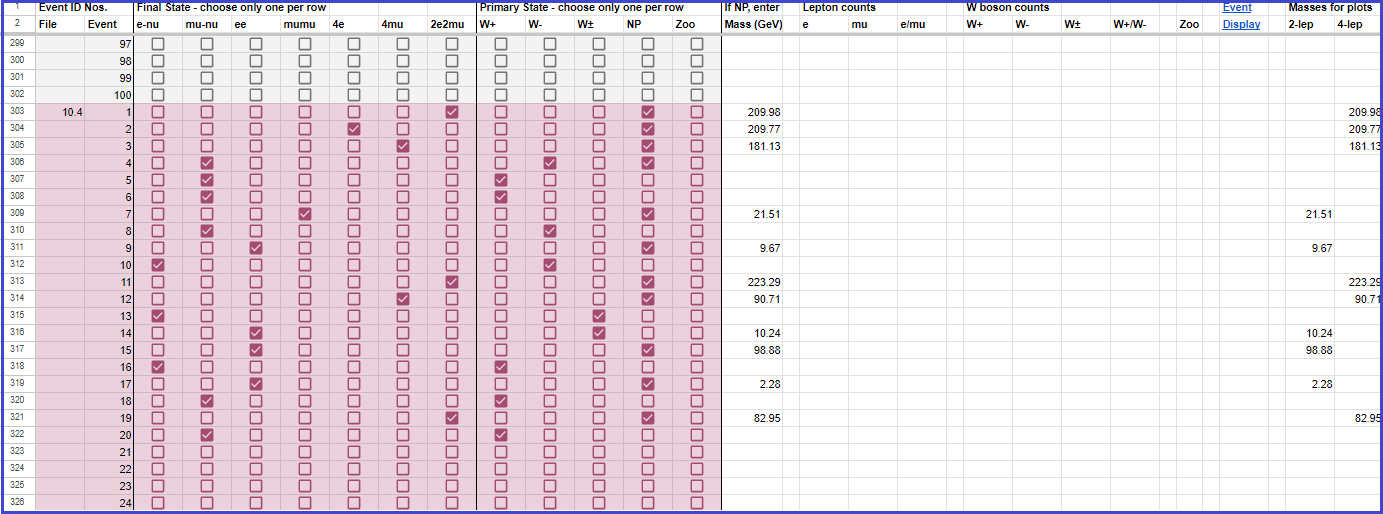
Here are combination statistics and plots:
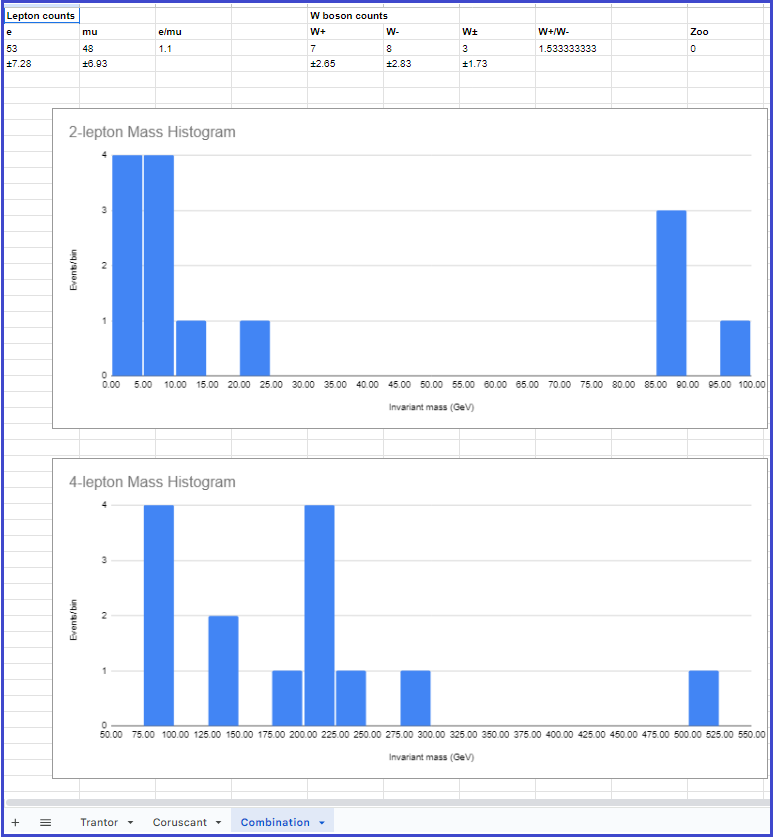
MINERvA
Small URL for this page: .
Navigation
- Neutrino Masterclass Project Map
- Screencasts
- Online tools
- Start of masterclass day
- Shift training
- Data analysis
- Understanding results
Remote Masterclass? Students need more prep? Try MINERvA Instructional Screencasts!
First things: prepare ahead
Each computer should have robust internet access. Two students should work together at each computer to complete a 50 events dataset. Before the masterclass, mentors, tutors, and teachers should:
- Schedule and participate in an online Orientation.
- Review the MINERvA Masterclass Documentation and Understanding MINERvA Masterclass Results.
- Try out the measurement. Use the practiceTuples and Practice Spreadsheet.
- Prepare a presentation on particle physics and neutrino experiments.
- Review the MINERvA Masterclass Measurement slides (PPT) (PDF).
- Go over all the steps in this page.
- Prepare and test your Zoom connection.
Students arrive
This should occupy the first 30-60 min
- Registration: please have students sign in on a registration sheet with name, school, and teacher.
- Gateway experience: have a cloud chamber, e/m apparatus, or something similar to whet interest
- Ice-breaker activity: students in small inhomogeneous groups create 1-2 good questions about particle physics, neutrinos, MINERvA, and/or DUNE.
Shift training
Get students ready for their data analysis shift! This will take about 3 hours, though parts of it can be moved to other times of the day.
Mentor presentation, 30-60 min:
- keep it interactive - ask questions about prior experience, shows of hands, wild guesses, etc.
- give students something to touch, e.g. a wave-shifting fiber
- connect to classroom prep
- touch on standard model
- talk about your research
- Focus on theme of MINERvA masterclass: using a neutrino beam from Fermilab to probe the atomic nucleus and better understand weak scattering in preparation for DUNE.
Tour, 30-60 min:
- adds much to the day - often most popular part
- if you have an accelerator to show, great!
- if not: any interesting labs, even if not particle physics, are still great
- have enthusiastic grad students around to chat and explain
Analysis Prep (30-60 min):
- Have a teacher lead this if practical.
- Use/adapt the MINERvA Masterclass Measurement slides (PPT) (PDF).
- Important: go through "masterclass-samples" in ARACHNE Simple on the projector with the students:
- Show students how to navigate to a data file.
- Discuss how to use the tools in ARACHNE.
- Discuss each event in terms of:
- Signal vs. (vertex or recoil) background
- Where the neutrino goes, where the vertex is, muon and proton tracks
- Copying kinematic data to the spreadsheet.
- What we plan to do with the recorded data.
Lunch with a Physicist (30-60 min):
- This is also very popular and a great way for students to interact and get comfortable with scientists.
Data Analysis
This is the heart of the masterclass and takes about 60 min. There should be 2 students at each computer, cooperating to get their data measured. Mentors, tutors, and teachers should circulate to help the students analyze the events and work out any problems they have. Don't give them answers. Help them figure things out and learn to see data as scientist does.
- Instructional Screencast
- Student Start Page - give students http://tinyurl.com/minervastudent
- Cheat Sheet
Data Assignments 2024:
International Masterclasses
| Date/time (U.S. Central Time) | Institute (Data Group) | Institute (Data Group) | Spreadsheet |
|---|---|---|---|
| Fri 08 Mar/15:00 | Lead (B) | Vermillion (A) | FNAL-MINERvA-2024–03-08 |
| Sat 16 Mar/14:00 | Duluth (C) | Mayaguez (F) | FNAL-MINERvA–03-16a |
| Sat 16 Mar/17:00 | Irvine (E) | FNAL-MINERvA–03-16b | |
| Fri 22 Mar/09:00 | Constantine (D, G) | Durham, UK (A, B, C) | FNAL-MINERvA-2024–03-22 |
| Mon 25 Mar/09:00 | Valencia (A, B, F, G) | FNAL-MINERvA-2024–03-25 |
*no videoconference
If >50 students are expected, contact Masterclass Coordination for more data groups.
All MINERvA Data for International Masterclasses:
- mergedTuples 1-25
- mergedTuples 26-50
- mergedTuples 51-75
- mergedTuples 76-100
- mergedTuples 101-125
- mergedTuples 126-150
- mergedTuples 151-175
- practiceTuples (includes teacherTuple and Archive)
Each mergedTuple has ~50 "gates" with multiple events. The student must find the useful event, if it exists, in each gate.
Sharing Results
This takes a little over one hour. Both parts are important.
Discussion (30-45 min):
- Mentor leads, students interact.
- View and discuss combined plots for your institute in spreadsheet.
- Student/small group discussion questions (version 1) - make a copy of this Google doc
- Student/small group discussion questions (version 2) - make a copy of this Google doc
- Student/small group discussion questions (version 2) - PDF
- Help students analyze histograms to find:
- Neutrino beam momentum and energy
- Uncertainty in px and py
- Estimate of carbon nucleus radius using Uncertainty Principle and Fermi Gas approximation
- Discuss meaning of result for understanding nucleus and weak scattering.
For more information, see Understanding MINERvA Masterclass Results.
Videoconference (30-45 min):
Connecting to videoconferences:
Course of a videoconference:
- Connect to videoconference link or Indico page (see above).
- Someone should log into the videoconference 15 min early to be sure the connection is established. See the Schedules page.
- Follow the agenda on Indico:
- Introductions and warm-up
- Institute results
- Combined results
- Discussion, Q&A, and wrap-up
- It is good to have a student spokesperson but try to arrange so it is not too hard for another student to make a comment or ask a question.
After this, we have post-discussion and closeout.
Before you go home:
Please report your attendance numbers on our Attendance Form!
We ask teachers, tutors, and mentors to fill out a short survey within a day or two after the masterclass.
Have a great day!
MINERvA doc
External Links:
- MINERvA Masterclass website
- MINERvA masterclass guide
- Neutrino Masterclass Library
- International Masterclasses
- PDF of this page
MINERvA Masterclass Measurement
Created by K. McFarland, K. Cecire, R. Fine, M. Carneiro, N. Tagg, QuarkNet LHC-Neutrino fellows
The MINERvA masterclass measurement is supported for International Masterclasses.
Contents:
- Description
- Requirements for hardware and software
- Outline of the day
- Pedagogy
- Student procedure
- Presentation of results
- Sample questions
- Moderators
- Material for students and teachers

(Credit: Fermilab)
Description
The MINERvA masterclass measurement enables students to examine actual events from the MINERvA detector in the MINOS neutrino beamline at Fermilab and draw conclusions based on categorization of the data and the kinematics of the interactions. There are both background and signal events. In each signal event, a neutrino penetrates a nucleus in a carbon target and undergoes a weak interaction with a neutron in that nucleus:
νμ + n0 → μ- + W+ + n0 → μ- + p+ .
In short, the neutrino interacts with the neutron to become a muon, causing the neutron tobecome a proton. (Note the net change in charge is zero.) The interaction is mediated by a W boson. The resulting muon and proton exit the nucleus with considerable momentum, which came from the original neutrino. While MINERvA cannot directly detect the neutrino, it can detect and measure the kinematics of both the muon and the proton that emerge from the interaction.
Students can find this kinematic information the ARACHNE, the MINERvA event display that they use to visualize the events. The students can then put this inofrmation into a spreadsheet which applies conservation of momentum to give the momentum of the system prior to the interaction in three dimensions. The z-direction is, in the coordinate system of the experiment, the initail beam direction. The initial momentum in z is the momentum of the neutrino plus the momentum of the neutron, if any, before the collision. The momenta in x and y, then, if there is any, would be due solely to the neutron.

Part of MINERvA signal event as seen in ARACHNE.
For more details, see Undertanding MINERvA Masterclass Results.
Software/Hardware
The entiire MINERvA masterclass measurement runs online in a browser. Masterclass leaders should test ARACHNE (including choosing a track and copying kinemetics) and Google Sheets in the computers and browsers to be used ahead of time.
Masterclass General Plan
All masterclasses share a pattern for the masterclass day. Neutrino masterclasses are no different in this case. The main elements of the plan are:
- Intro/warmup
- Introduction to the physics (neutrino physics , weak interactions, MINERvA experiment)
- Lab tour, if available
- Introduction to the masterclass measurement (ARACHNE, student spreadsheet, how to measure)
- Lunch with physicists
- Masterclass measurement
- Discussion of results
- Videoconference.
For neutrino masterclasses in particular, these resources will help:
- Particle cards activity
- Template for introduction to neutrino physics
- Template for introduction to measurement
- Notes on measurement (below)
- Notes on videoconferences.
Pedagogy
Enduring Understanding:
Indirect evidence provides data to study phenomena that cannot be directly observed.
Objectives:
- Apply conservation of momentum and energy to measure the approximate energy of a neutrino beam from the Fermilab accelerator complex.
- Apply conservation of momentum and energy to measure the properties of neutrons in nuclei of atoms in the target of a neutrino beam.
- Determine which events are signal events from which effective measurements may be made and which events are background that cannot be used for measurements.
Student Procedure
Screencast: https://tinyurl.com/minerva2019mc.
Here is the general outline of what the students do:
- Students work in pairs: two students to one computer.
- Each pair of students is assigned one mergedTuple (a 50-event dataset) from a Data Group assigned to their masterclass from the Data Analysis section of the MINERvA page of the Neutrino Masterclass Library,
- Students examine each event to determine if it is signal or background.
- If the event is determined to be backround, the students skip to the next event.
- If the event is a signal event, students move the cursor to each of the two tracks that emerge from the vertex and choose them. Momentum and kinetic energy data will appear for the track. Students can copy this data and paste it into an online spreadsheet.
- Note: Each masterclass is assigned a sheet in Google sheets. This means:
- The masterclasses that will meet together in a particular videoconference are all assigned the same instance of Google Sheets with a unique URL. Thus, if Boston, Prague, and Mazabuka are meeting in a videoconference, they get their own place Google Sheets.
- Each masterclass then has its own individual sheet inside that place. It is located as a tab at the bottom and is marked with either its assigned mergedTuples or the location, e,g, Boston. The students in Boston put their data, line-by-line, according to their mergedTuple and the Entry (event window, called a Gate), into their sheet in their tab. (This is pasted from the event display.)
- The spreadsheet will calculate pz (in the beam direction), py, px, and pt (transverse momentum calculated from px and py).
- The sheet combines student data to make a histogram of values of pz. Each value of pz represents the momentum of the neutrino before the interaction plus the moemntum of the taget neutron in the z-direction, if any. Guided by the masterclass leader, students can make a histogram of pz for all of their events.
- Students make similar measurements of px and py. Since they are transverse to the beam, they represent components of the momentum of the target neutrons only, if there is any.
Main steps for students in data analysis:
First step: Find events.
Each pair of students goes to the Student Start Page where they find their assigned Data Group and spreadsheet.
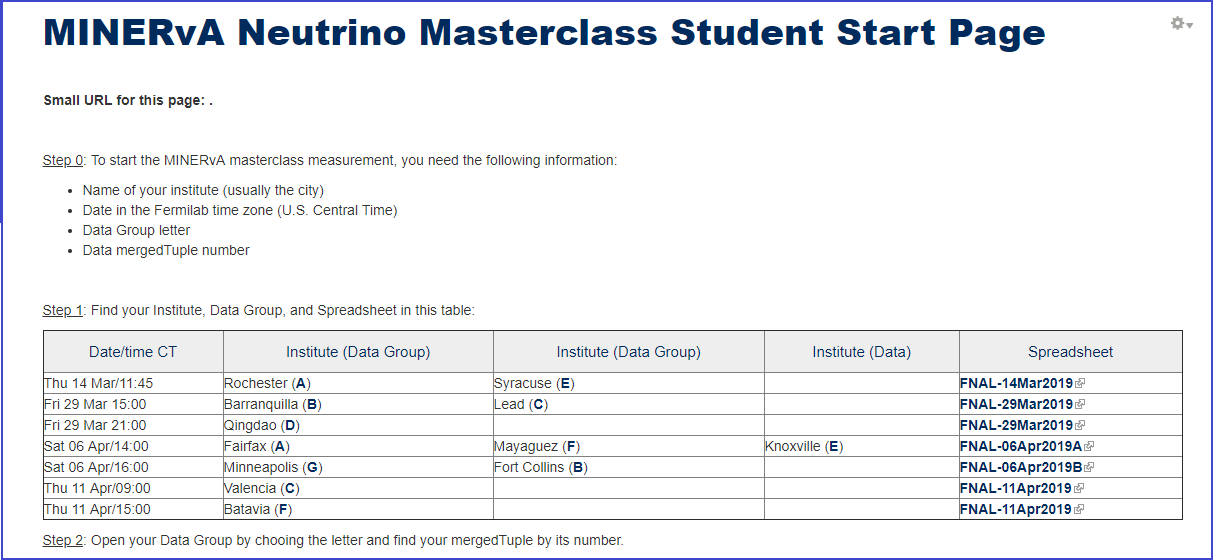
Second step: Open and use Arachne.
The masterclass leader should tell each pair of students their mergedTuple and help them find it in the data group and spreasdsheet . When they choose the mergedTuple, Arachne will come up in a new tab on the browser, which will open at the initial time Slice in the first Gate (shown as Entry 0; the next Gate will be Entry 1, etc.). In most cases, it will not initially show the event for which the students are looking. They must find it, if ti is there, by advancing from Slice to Slice within the Gate.
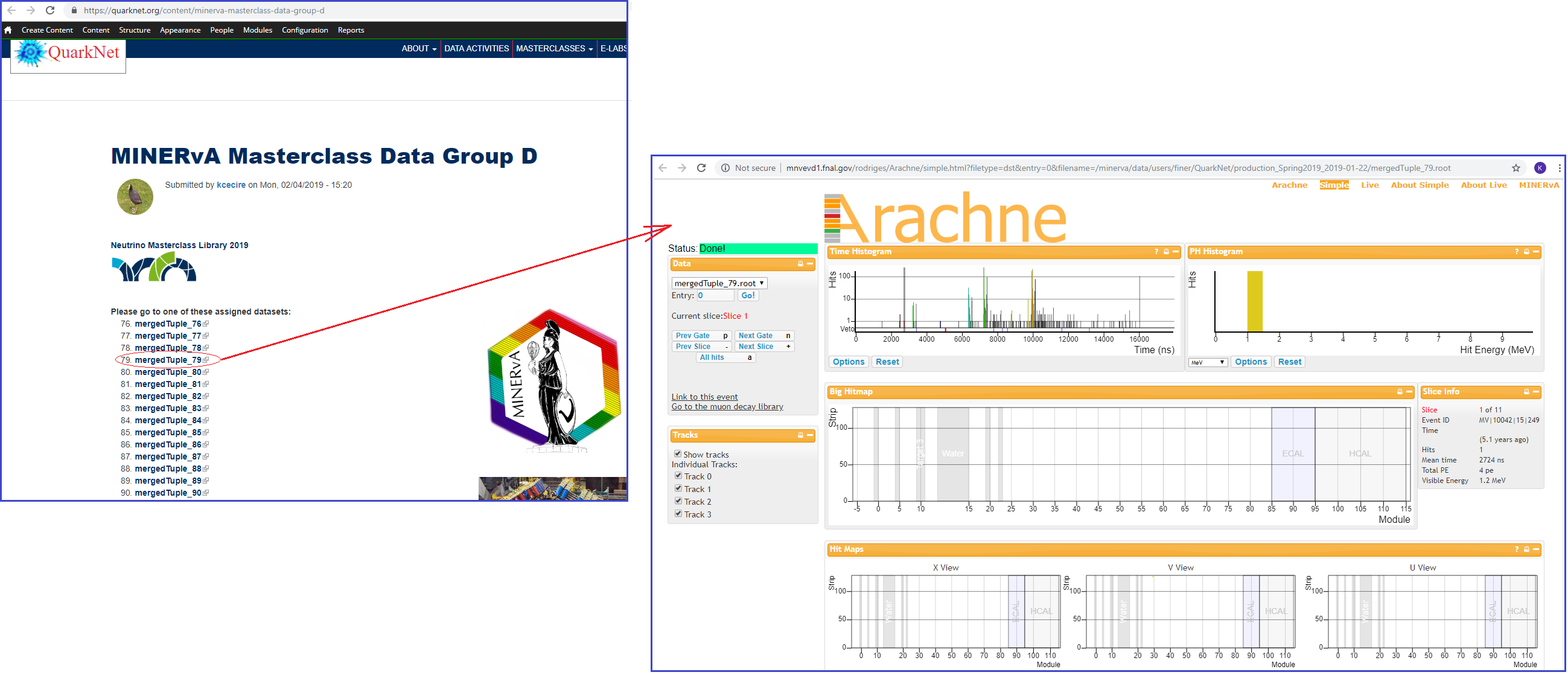
Students choose Next Slice, which moves a slightly later time in the Gate with each click. The progress can be seen in the Time Histogram in Arachne. Students advance the Slice until they find an instaance of one long track and one short track coming from a common vertex. This is the actual event theyi seek.
In this particular Gate, we find two possible events but both are background. The first has two short tracks rather than one:
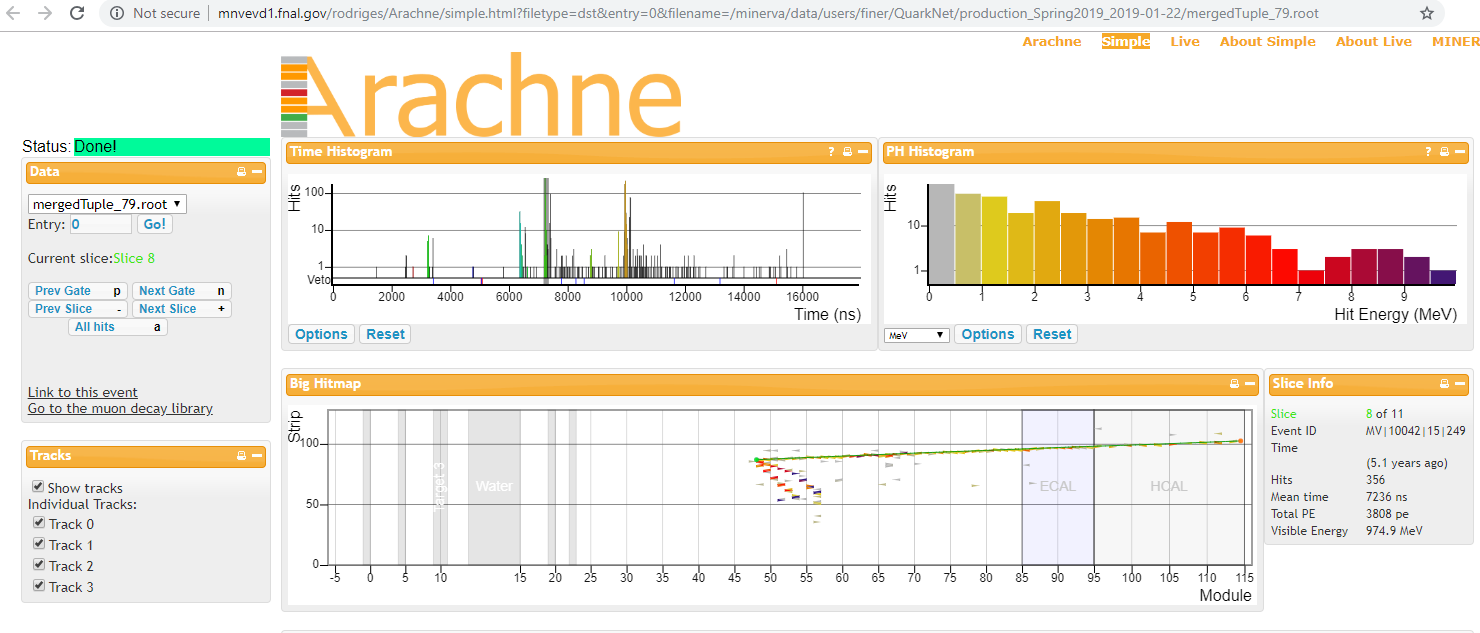
That means is is not a signal event. Note that time has progressed to a little over 7000 ns in the Time Histogram. This is also background from a later Slice in the same Gate:
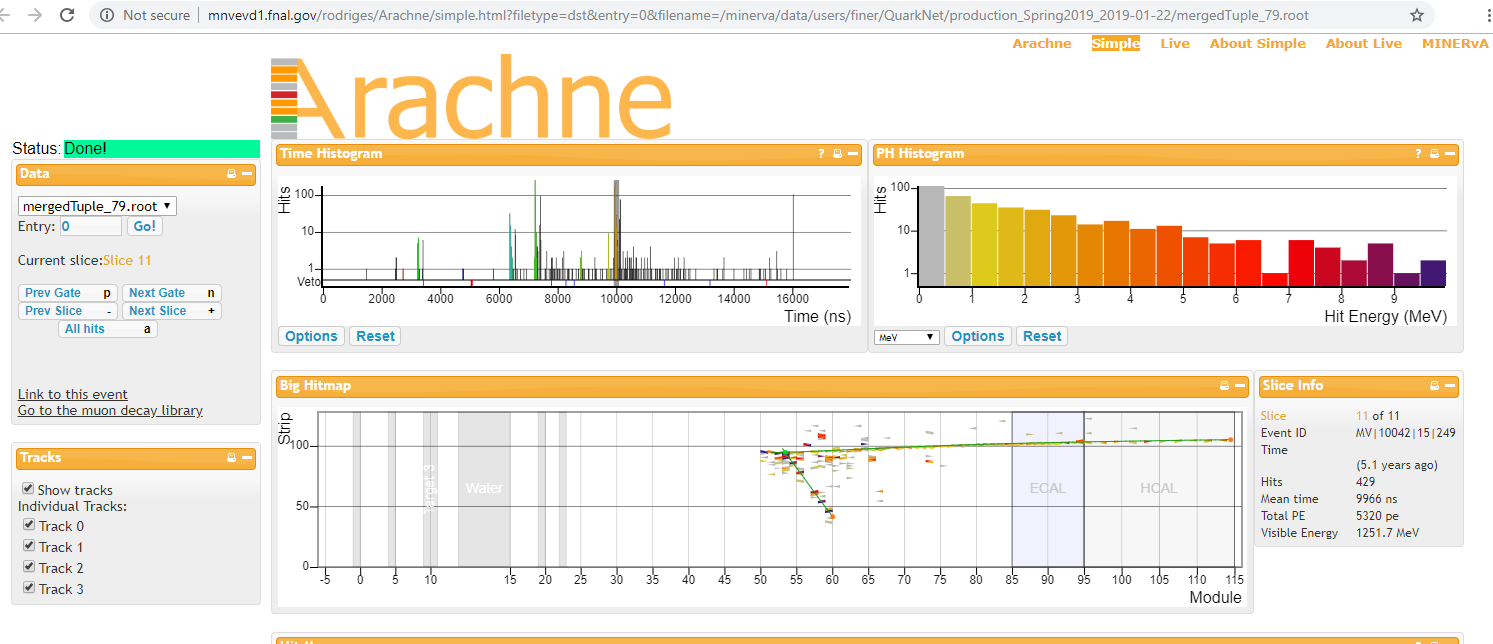
This not only has a an extra track which appears to go backwards (negative z direction) from the vertx but several lines of red and orange dots also coming from the same place.
Here is an example of a good signal event:
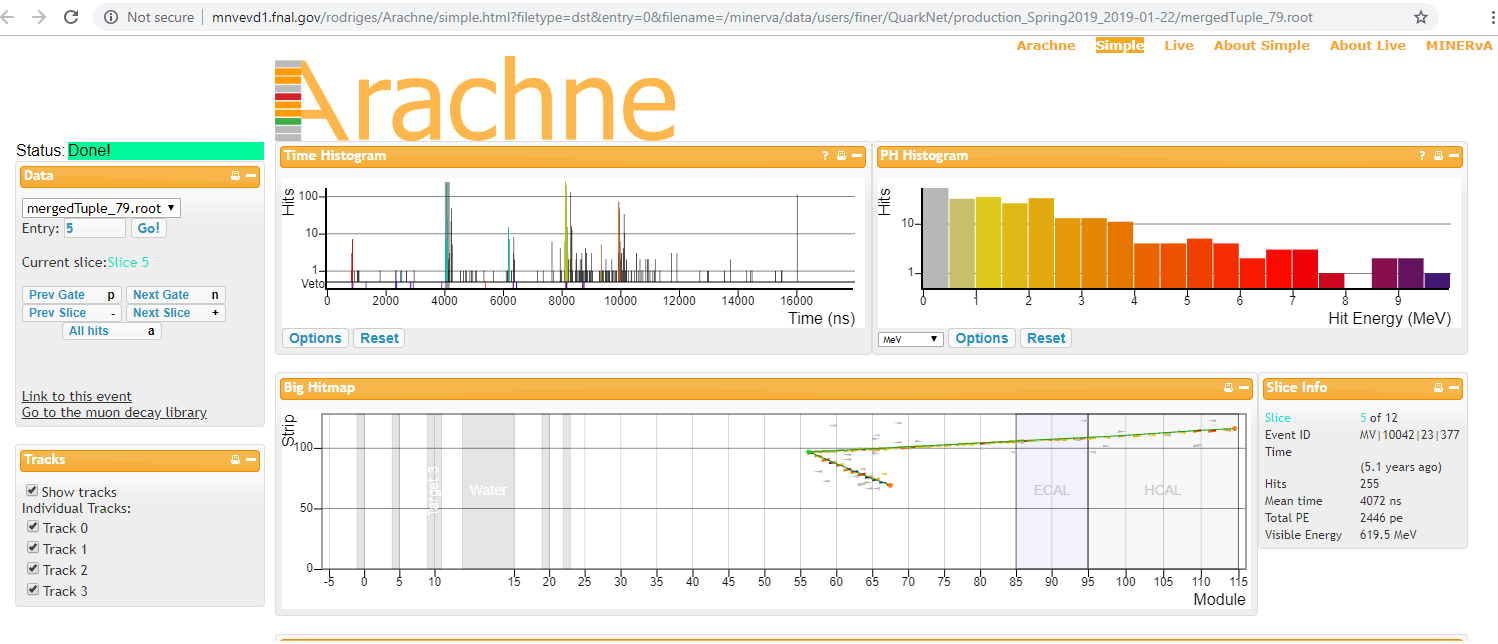
Note we are in a different Gate. This is close to a "classic" event: one clear long track for the muon and one clear short track for the proton. (The muons track is always the longer of the two.)
Now the students can find the kinematics from each track. First, they choose one of the two tracks. Here we picked the long muon track first:
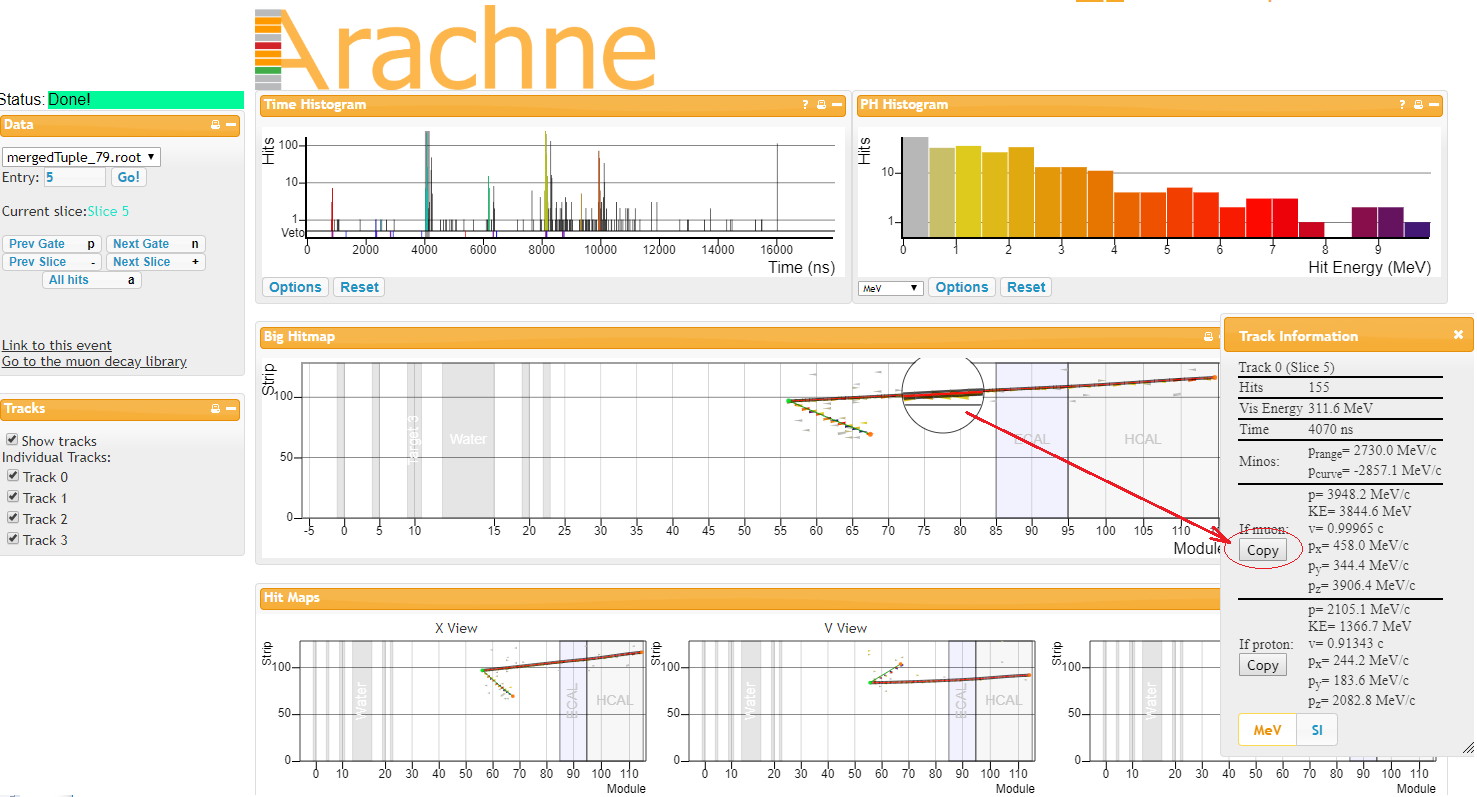
Third step: Enter data into the spreadsheet.
When students choose a track, the Track Information box pops up. Because this is a muon, they choose the Copy button for a muon. This copies the kinematic data for the muon onto the computer clipboard. It is then pasted at the appropriate place in theie assigned Google sheet, in this case in the row for mergedTuple 79, Entry 5 and in the column under Muon KE (MeV):

The students next choose and copy for the proton:
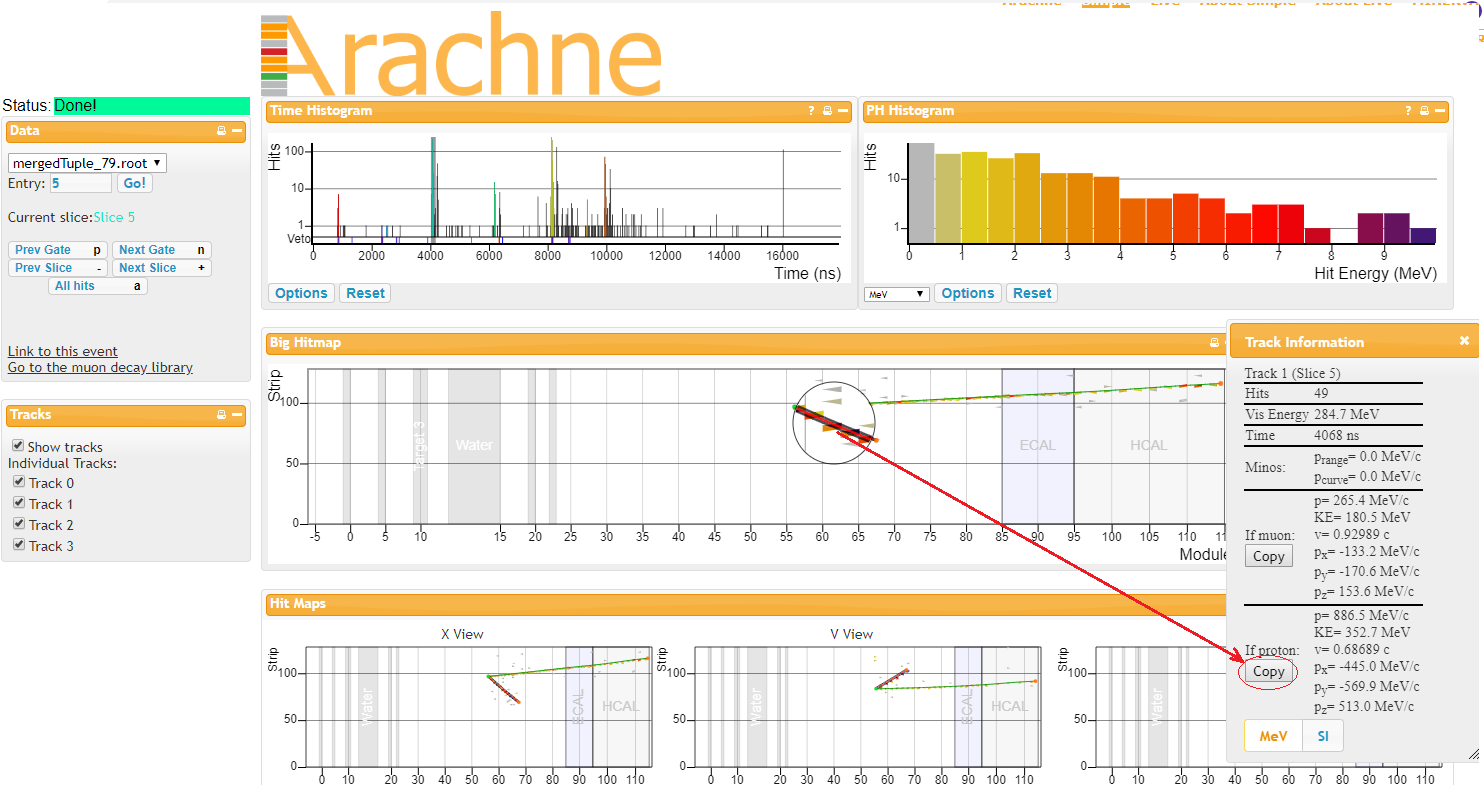 Then paste the proton kinematics in the next cell to the right of the muon numbers:
Then paste the proton kinematics in the next cell to the right of the muon numbers:
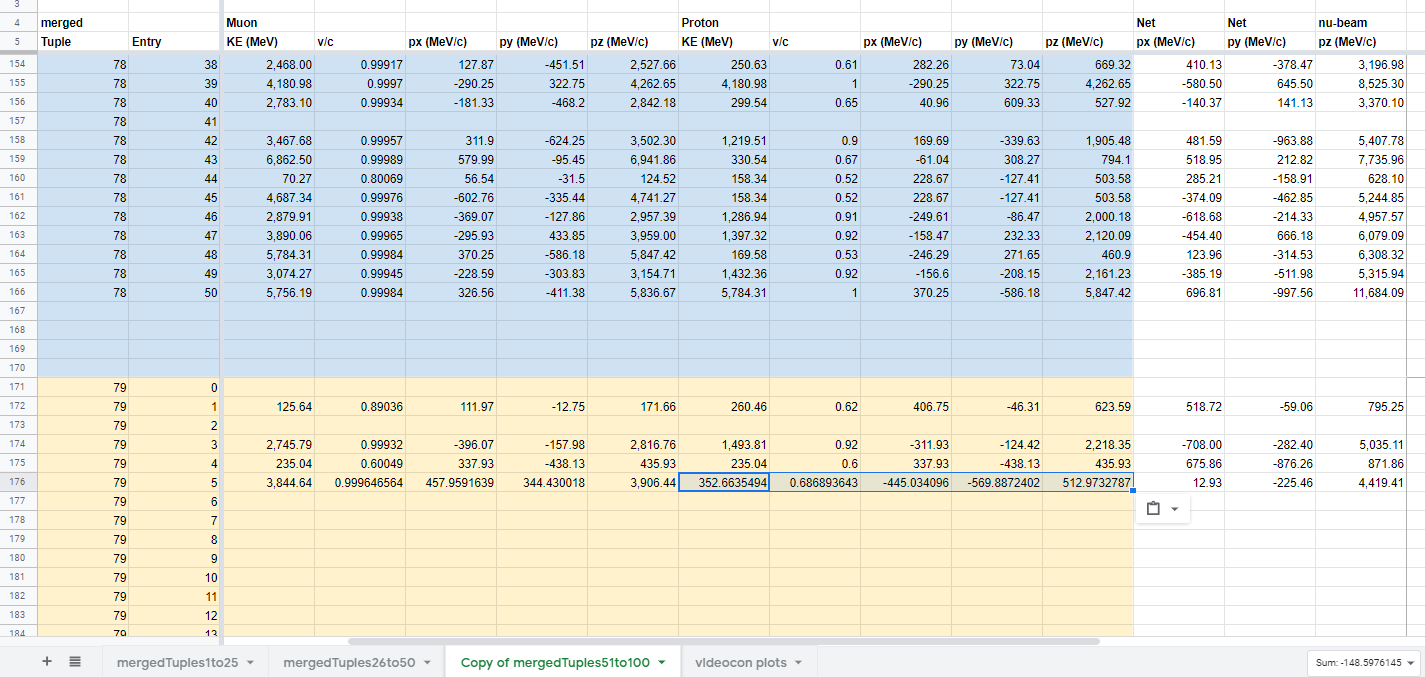
Note that the spreadsheet automatically calculates initial px, py, and pz.
Students do this for all 50 entries (or gates), leaving empty rows only when the gate has no veriable signal event.
About background events
Signal events have a "clean" vertex and undiverted tracks for a proton (short track) and a muon (long track). There may be some splotches of light gray near the vertex; these are low energy deposits in the detector and can usually be ignored.
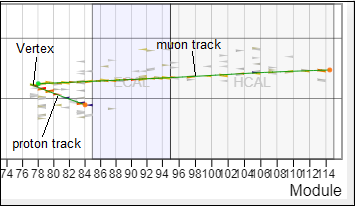 | 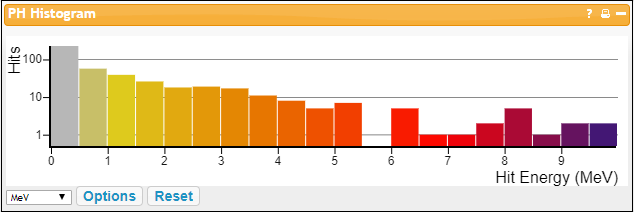 gray to red to blue. |
The two main types of backround event are Vertex and Recoil.
- Vertex background events have ejecta from or near the vertex of the long muon track and short proton track which frustrate an attempt to accurately measure momentum and energy.
- Recoil background events have muon or proton tracks which show signs of having radiated an unseen particle or collided with an unseen particle. The main sign of this would be a track with a "knee" or a "kink" in its path.
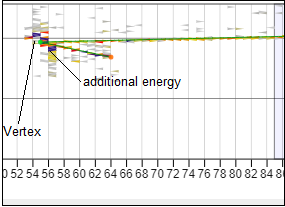 | 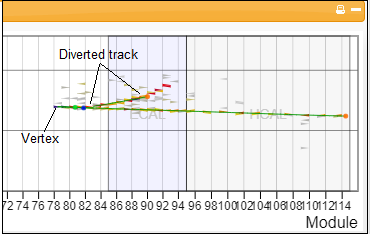 |
In addition, many background events are just outside parameters for a signal event. They may have too many tracks or many "splotches" of significant extra energy or are simply hard to understand. (Physicists usually call these latter kind, if they are odd enough, "zoo" events.)
The good news: students do not need to categorize background events - just skip them!
Presenting and Understanding Results
Masterclass leader must help students to interpret results in a physics discussion after the measurement. We refer you again to Understanding MINERvA Masterclass Results.
For each masterclass, plots of pz, px, and py for all signal events measured will appear at the bottom of the specific sheet in Google Sheets used by that masterclass. Each plot should be roughly Gaussian. Masterclass leaders should guide students to these 3 discoveries:
- The central value in the pz plot represents the beam momentum. Since each neutrino has very little mass but significant-enough momentum to be relativistic, pz in MeV/c is effectively the same number as energy E of the neutrino beam. If nothing else, the students will leave the mastecrclass knowing the MINOS neutrino line beam energy becuase they will have measured it.
- The values of px and py represent neutron momenta in the x- and y-directions, transverse to the neutrino beam. If these cluster narrowly around zero, then the neutrons are at rest when they interact with the neutrinos. If there is more like a Gaussian distribution, they hav etheir own momenta inside the nucleus. Thus students can conclude from a robust distribution that the neutrons do indeed have their own momenta - and thus motion - inside the nucleus.
- The widths of the distributions in px and py represent two meaurements of the uncertainty in the momentum of the neutron inside the carbon nucleus. Application of the Heisenburg Uncertainty Principle will then yield the uncertainty in position. An adjustment for the neutrinos behaving approximately as a Fermi gas doubles this number. This is the uncertainty in the position of the neutron and should be on a scale similar to the radius of a carbon nucleus.
The plots should appear at the top of the sheet to the right of of the data and look something like this:
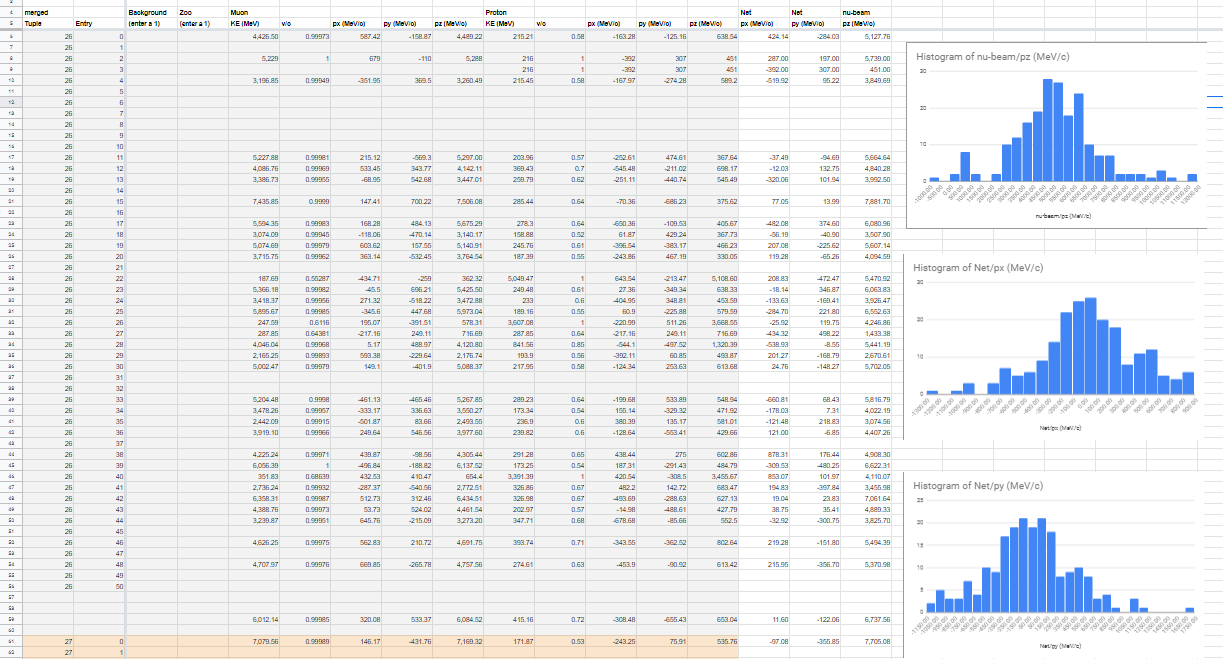
For px and py, the uncertainties can be roughly measure as the full-width at half-maximum of the plot.divided by 2. Students and masterclass leaders are asked to measure these from the plots and enter these into the Google sheets just below those plots.. The Google sheet will then make the cal
Much MINERvA research is dedicated to understanding the full interaction - νμ + n0 → μ- + p+ plus whatever interactions the muon and the proton have with other parts of the nucleus as they energy.
Moderators
Fermilab-based moderators should refer to the FNAL Masterclass Moderators page.
All moderators should note the following:
- The videoconference should last about 30 minutes. It sometimes runs over but be careful to not use up too much time, especially in the first half. Keep answers and explanations brief and to the point. Do not veer off into details or additional related physics.
- If there is only one masterclass group assigned to the videoconference, there is no need for combination of results. Rather, allow the single group to explain their results to you; ask probing and encouraging questions.
- If there is more than one group, still allow each group to explain their result but limit it to only 1-3 minutes. Ask questions.
- Combination plots are in the "videocon plots" tab of the Google Sheet. The spreadsheet calculates standard deviation for the px and py plots as well as Δpx, Δx. Δpy, and Δy. Please discuss these results with the students and compare them with the results for a single group. Ask more questions.
- The last part of the videoconference is for students to ask questions of you. Be sure there will be time for this. They are instructed to be wide-ranging in their questions.
The plots and calculations look like this:
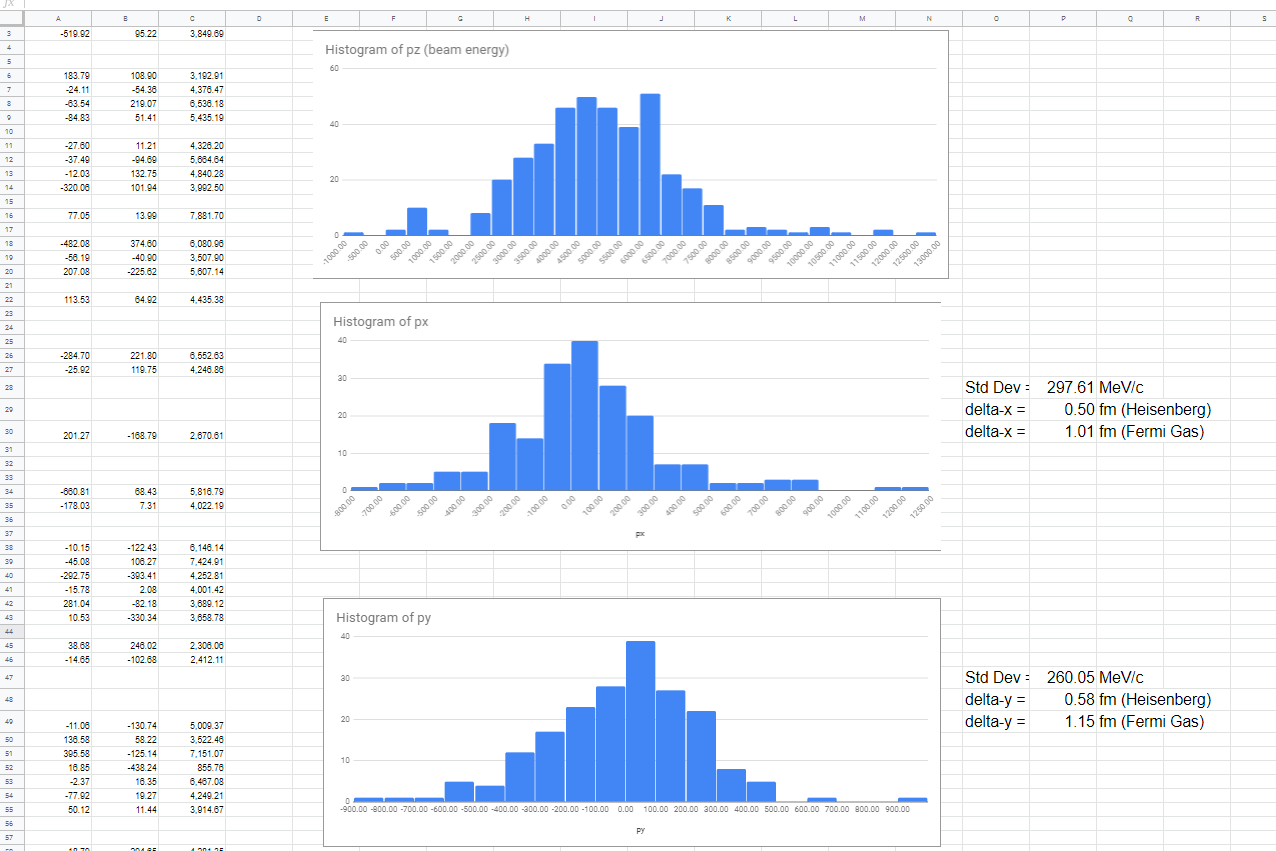
References and materials
- MINERvA (Fermilab) page
- International Masterclasses
- QuarkNet (for Neutrino Masterclass Library, go to MASTERCLASSES > NEUTRINO PROJECT MAP)
- Useful Wikipedia pages:
- All the data:
Understanding MINERvA
Navigation
- MINERvA Masterclass Documentation
- MINERvA Masterclass Guide
- Neutrino Masterclass Project Map
- MINERvA Masterclass website
This document is intended for masterclass leaders and physics teachers as a guide to explaining the results of the MINERvA masterclass to students.
Pedagogy
Enduring Understanding:
Indirect evidence provides data to study phenomena that cannot be directly observed.
Objectives:
- Apply conservation of momentum and energy to measure the approximate energy of a neutrino beam from the Fermilab accelerator complex.
- Apply conservation of momentum and energy to measure the properties of neutrons in nuclei of atoms in the target of a neutrino beam.
- Determine which events are signal events from which effective measurements may be made and which events are background that cannot be used for measurements.
Physics
Interaction:
A muon neutrino encounters a carbon nucleus in the targer area of MINERvA. It strikes a neutron in the nucleus and interacts by emittiing a W+ boson. The W+ is absorbed by a down quark in the neutron, changing it to an up quark and transforming the neutron into proton. When the neutrino emits the W+, it transforms into a muon. Both the muon and the proton carry the original momentum of the neutrino and thus move rapidly away from the carbon nucleus into the detector modules.
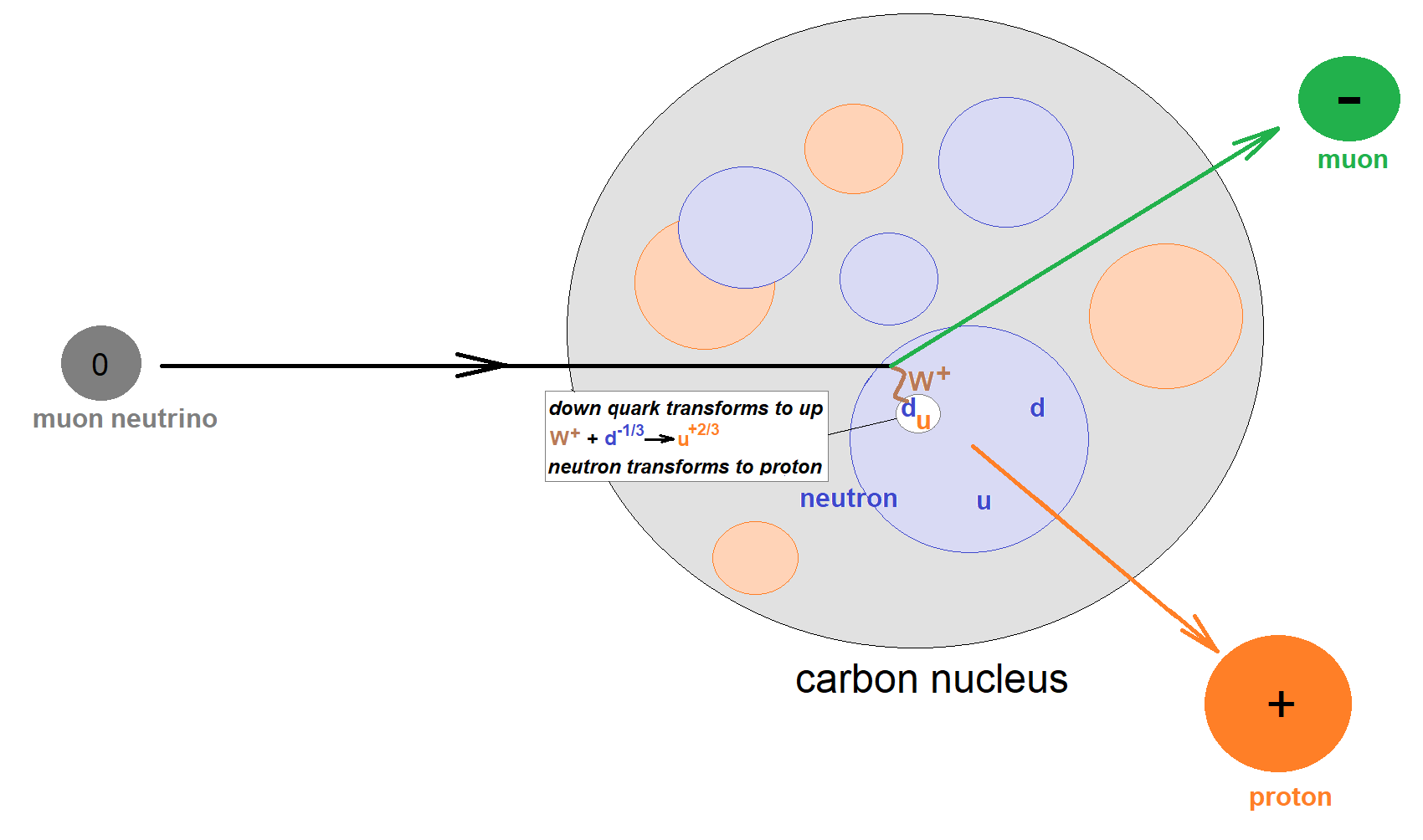
Beam momentum and energy:
The defined z-axis of the detector system is aligned to the direction of the Fermilab neutrino beam. The histogram of values of pz should make a normal distribution with the peak at the central value of the neutrino momentum in MeV/c. Since the masses of the neutrinos are extremely small and the momenta are quite high, the same number in MeV is the beam energy.
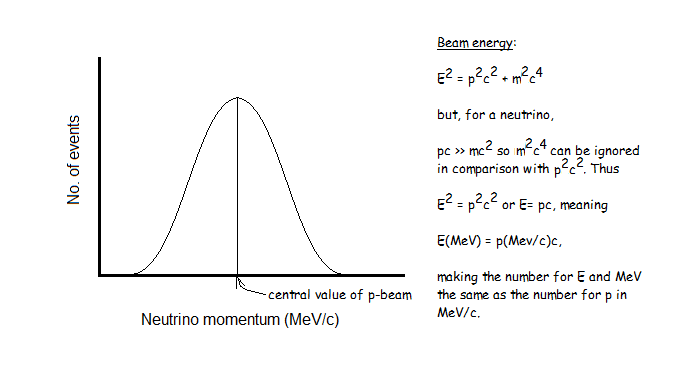
Momentum in x- and y-directions:
Since the momenta of the neutrinos are in the z-direction by definition, the net momenta they give to the outgoing protons and muons in the x- and y-directions must be zero. If the neutrons are initally rest before the interaction, then the histograms of net px and net py must peak at zero and be quite narrow. If there is a wide distribution, then the momenta in x and y must be random and mostly non-zero, producing a fairly wide normal distribution centerd on zero.
The uncertainty in the distribution of px or py can be estimated as half of the Full Width Half Maximum (FWHM/2). To find this, find the level halfway below the peak and measure the width of the distribution at that point. Divide by 2.
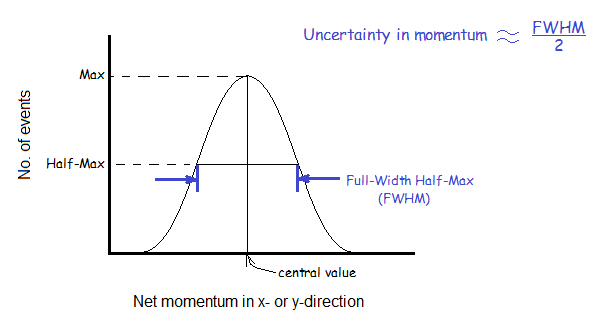
Radius of Carbon Nucleus:
The radius of an atomic nucleus in Fermi (fm; 1 fm = 10-15m) is extimated using the equation
R = (1.25 fm)A1/3,
where A is the atomic mass number. For carbon, A = 12 and therefore
R = (1.25 fm)(121/3) = 2.7 fm.
If the neutrons in carbon have their own momenta then they are constrained in their movement by the radius of the nucleus. If we understand the process of the neutron-neutrino interaction and resulting ejection of the proton and muon well enough, our x- and y-momentum data analysis should yield a reasonable estimate of this distance-of-travel constraint, that is, 2.7 fm, as the uncertainty in position of the neutron.
Calculation of Δx or Δy:
We shall examine Δx only as the analysis of Δy is identical.
The Heisenburg Uncertainty Principle states that the uncertainties in position and momentum form a complimentary pair, the products of which are no smaller than Planck's constant divided by 4π, or
ΔpxΔx ≥ h/4π.
Using momentum in MeV/c and distance in fm, it turns out that h/4π is about 150 MeV-fm/c. However, this assumes that the neutron is completely free to move. It is not as it is bound to quantized energy states in the nucleus and no two of them can occupy the same state due to the Pauli Exclusion Principle. A collection of particles that behaves this way is called a Fermi Gas; the Fermi Gas approximation of the behavior of the neutrons just about doubles the constant in the Uncertainty Principle to 300 MeV-fm/c. Then the uncertainty in x is estimated as
Δx = (300 MeV-fm/c) / Δpx.
If this number is significantly less that the carbon nuclear radius of about 2.7 fm, then there is more physics needed to fully understand the interaction. Getting the interaction right is one of the main purposes of MINERvA and is needed to make precision measurments of neutrinos in DUNE.
Addendum:
Rick Dower of the Boston QuarkNet Center prepared a thorough treatment showing mathematically how the distributions in momentum must be from quantum effects and not from thermal noise: Neutrino Target Motion.
NOvA
Small URL for this page: .
Navigation
- Neutrino Masterclass Project Map
- Screencasts
- Preparation
- Physical space set-up
- The agenda outline
- Opening activities
- Mentor presentation
- NOvA Overview and Analysis, Part 1 - Far Detector
- NOvA Analysis, Part 2 - Near Detector and Conclusions
- Discussion of Results - Understanding the Results
- Videoconference (optional)
- Data and data analysis tools
Notes:
This page is meant to guide masterclass leads: physicists, teachers, tutors, etc. Students participating in the NOvA masterclass can access data and tools through the Student Start Page.
Remote Masterclass? Students need more prep? Try NOvA Instructional Screencasts, coming soon!
Preparation Before Masterclass Day
Before the masterclass, mentors, tutors, and teachers should:
- Schedule and participate in an online Orientation.
- Create an agenda for the masterclass day.
- **Check with participating teachers and students to ensure they have access to Google Colaboratory**. Some schools block this feature; school IT staff may be able to unblock this feature. A personal Google account should grant access to Google Colab. Students may also partner up with another student who has access to Colab, or they may utilize the alternative Binder site.
- Prepare or invite a speaker to give a presentation on particle physics and/or neutrino experiments.
- Try out a Python Coding exercise, such as the ones linked below:
- Remind participants that they will need a laptop (or a Chromebook or a similar device) during the event.
- Check that the space that will be used for the masterclass has appropriate internet access available.
- Review this entire page, which contains information on the NOvA Measurement and how to understand the results.
- Print out cheat sheet - one per student.
Physical Space Setup
The below assumes a classroom-like space, with a large front white board. Similar setup could also be achieved with two or three free-standing easel poster boards.
- Provide information for participant internet connection (Wi-Fi information, etc.)
- Provide a link, preferably shortened, to the agenda page for the day. This is where students will access their data and coding notebooks.
- Post the following in the room for reference throughout NOvA masterclass:
- From left to right, write "Neutrino Beam Source", "Near Detector", and "Far Detector" on a whiteboard or poster paper that will serve of the relative layout of these three important components of the NOvA experiment. These posters will also serve as a locations to post CC/NC ratios at each detector for comparison. It is recommended to write the overall NOvA masterclass goal on the board or poster paper as well. Refer to the diagram below for an example of this set-up.:
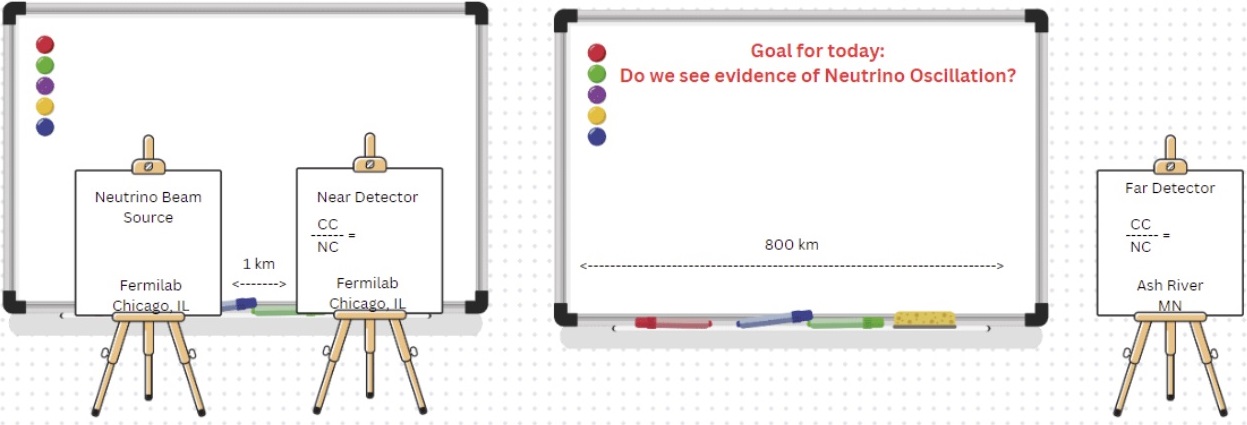
The Agenda (Click here for an example agenda.)
Opening Activities: (~30-60 min) - optional
- Registration: please have students sign in on a registration sheet with name, school, and teacher.
- Have students participate in an ice-breaker activity.
- As a large group, have a Setting the Stage discussion to provide scope and context of physics and particle physics.
Mentor Presentation: (30-60 min) - highly encouraged
- Speaker could be a physicist or physics graduate student.
- Keep it interactive - ask questions about prior experience, show of hands, wild guesses, etc.
- Connect to classroom prep
- Touch on standard model, neutrinos, neutrino oscillations, and his/her research.
- Focus on theme of NOvA masterclass: looking for evidence of neutrino oscillation.
Tour or break: (30-60 min) - optional
- Tours add much to the day - often most popular part
- If you have an accelerator to show, great! Maybe a cloud chamber.
- If not: any interesting labs, even if not particle physics, are still great
- Have enthusiastic grad students around to chat and explain
NOvA Overview & Analysis Part 1 (NOvA Far Detector): (~60-90 min) - required
- Hand out cheat sheet
- Post goal of today's analysis: Do we see evidence of neutrino oscillation?
- NOvA Overview and Background - Slides 1-10
- Speaker notes on slides 1-10 - link coming soon
- Link to video referenced in slide 5 - How Do Neutrino Oscillations Work?
- NOvA Far Detector, Charged Current (CC) / NuMu Interactions - Slides 11-16
- Speaker notes on slides 10-16 - link coming soon
- Far Detector CC NuMu Events, Form, & Results/spreadsheet - See links in Data & Data Analysis Tools table (below)
- NOvA Far Detector, Neutral Current (NC) Interactions - Slides 17-20
- Speaker notes on slides 17-20 - linkcoming soon
- Far Detector NC Events, Form, & Results/spreadsheet - See links in Data & Data Analysis Tools table (below)
- Part 1 Conclusions - Slide 21-22
- Write this ratio of CC/NC on the board/poster labeled "Far Detector" in Physical Space Setup
- Write on the board the decided cut-off length that we will use to separate CC/Nu events from NC events. (This will be used in the code for part 2.)
Lunch with a Physicist: (~30-60 min) - highly encouraged
- You may have to move Lunch earlier or later in agenda, depending on your specific timing.
- This is also very popular and a great way for students to interact and get comfortable with scientists.
- Physics demonstrations - Bring in a couple of physics demonstrations that normally wouldn’t be available/accessible to high school physics programs. Demos involving liquid nitrogen are typically fan favorites!
NOvA Analysis Part 2 (NOvA Near Detector) & Discussion: (~60 min) - required
- NOvA Near Detector Analysis - Slides 23-24
- Python Near Event Analysis - Participant Version
- Do a “File Make a Copy”
- Github link
- "ANSWER KEY": Python Near Event Analysis - Completed Version (Do not share with students)
- Do a “File Make a Copy”
- Note: Depending on cut-off length, CC(NuMu)/NC ration will be anywhere between 0.40 or higher.
- Overall conclusions
- Write the ratio of CC/NC on the board/poster labeled "Near Detector" in Physical Space Setup.
- Discuss...do we see evidence of neutrino oscillation? What is your evidence?
Break or tour: (~10-30 mins) - optional
- Placement of this will vary based on your specific timing.
NOvA Videoconference - : (~30 min) - highly encouraged
- See "Sharing Results" below
- Note that student representative(s) should be prepared to present answers to these questions during the videoconference:
- What track length did you (as a group) decide to use to separate charged current (NuMu) events from neutral current events?
- Did you see evidence of neutrino oscillation? What is your evidence and reasoning?
End of day
Data and Data Analysis Tools
This is the heart of the NOvA masterclass and takes about 2 hours: ~1-1.5 hours for Part One (NOvA overview and Far Detector training & analysis), and ~1 hour for Part Two (Near Detector training & analysis and conclusions). There should be 2 students at each computer, cooperating to get their data measured. Mentors, tutors, and teachers should circulate to help the students analyze the events and work out any problems they have. Don't give them answers. Help them figure things out and learn to see data as scientist does.
- Instructional Screencast
- Student Start Page
- Cheat Sheet
Institute NOvA Data, Forms, and Spreadhseets 2024:
International Masterclasses
| Date/time CT | Institute | Far Detector CC Events | Student Form for Far Detector CC Events | Far Detector NC Events | Student Form for Far Detector NC Events | Spreadsheet |
|---|---|---|---|---|---|---|
| Sat 02 Mar/14:00 | Buffalo | CC/NuMu Data | BU-CCForm | NC Data | BU-NCForm | BU-02Mar2024 |
| Sat 09 Mar/15:00 | Minneapolis | CC/NuMu Data | MI-CCForm | NC Data | MI-NCForm | MI-02Mar2024 |
| Sun 10 Mar/15:00 | Fort Collins | CC/NuMu Data | FC-CCForm | NC Data | FC-NCForm | FC-10Mar2024 |
| Thu 21 Mar/13:00 | Puerto Colombia | CC/NuMu Data | PC-CCForm | NC Data | PC-NCForm | PC-21Mar2024 |
| Wed 27 Mar/14:00 | Curitiba | CC/NuMu Data | CU-CCForm | NC Data | CU-NCForm | CU-27Mar2024 |
| Sample Mar/00:00 | Sample | CC/NuMu Data | CC/NuMu Form | NC Data | NC Form | Sample-03Mar2023 |
*no videoconference
Sharing Results
Videoconference (~30 min):
Connecting to videoconferences:
- See the schedule on the Videoconferences page. (Scroll down to the 2024 Schedule for NOvA masterclass videconferences.)
Course of a videoconference:
- Click on the NOvA Zoom link on the videoconferences page refereced above. This will connect you to the Zoom videoconference. Note that the dates/times listed on the schedule are in U.S. Central Time. (Convert to your time zone.)
- Someone should log into the videoconference 10-15 min early to be sure the connection is established.
- Approximate agenda:
- Greetings (~5 min.)
- Students present answers to these questions (~5 min)
- What track length did you (as a group) decide to use to separate charged current (NuMu) events from neutral current events?
- Did you see evidence of neutrino oscillation? What is your evidence and reasoning?
- Pro result and/or virtual visit (~10 min.)
- Q&A (~10 min.)
- It is good to have a student spokesperson but try to arrange so it is not too hard for another student to make a comment or ask a question.
After this, we have post-discussion and closeout.
Before you go home:
Please report your attendance numbers on our Attendance Form! (TBD)
We ask teachers, tutors, and mentors to fill out a short survey within a day or two after the masterclass. (TBD)
Have a great day!
Videocons
CERN, GSI, and KEK videoconferences
Registration
Registration polls are closed. To register or obtain further information, please email the videoconference coordinator:
- CERN - Uta Bilow
- GSI - Yiota Foka
- KEK - Rok Pestotnik
Fermilab videoconferences
Registration and Schedules
Registration polls are closed. To register or obtain further information, please email the videoconference coordinator:
- Fermilab/LHC - Kenneth Cecire
- Fermilab/Neutrino - Shane Wood or Spencer Pasero
All schedules are tentative at this point. To request a change, please send us an email.
Connections
Fermilab institutes connect to videoconferences through Zoom. Channels are indicated in the schedule.
2024 Schedule for ATLAS masterclass videoconferences moderated by Fermilab
This will be updated as registrations are received.
Times (TBA) are in U.S. Central Time. (Convert to your time zone.) This schedule is in its preliminary stages and is subject to change.
| Date/time (U.S. Central Time) | Institutes | Moderator(s) | Staff | Zoom link (2) |
|---|---|---|---|---|
| Mon 04 Mar/15:00 | Stillwater | Norberg | Cecire | FNAL-IMC-A |
| Fri 08 Mar/15:00 | Ruston, Stillwater - joint ATLAS/CMS | Natale, Hogan | Cecire | FNAL-IMC-B |
| Sat 09 Mar/15:00 | Notre Dame, Santa Cruz, Stillwater - joint ATLAS/CMS | Natale, Malik | Wetzler | FNAL-IMC-B |
| Tue 12 Mar /13:00 (1) | DeKalb | Smith | Cecire | FNAL-IMC-A |
| Sat 16 Mar/14:00 | Stillwater, Turlock | Bhopatkar | Glover | FNAL-IMC-A |
Notes:
- U.S. Daylight Savings Time begins Sun 10 Mar. The schedule continues with the same local time intervals for Fermilab but move one hour ahead in non-U.S. time zones.
- Email for password.
2024 Schedule for CMS masterclass videoconferences moderated by Fermilab
This will be updated as registrations are received.
Times (TBA) are in U.S. Central Time. (Convert to your time zone.) This schedule is in its prelimiary stages and is subject to change.
| Date/time (U.S. Central Time) | Institutes | Moderator(s) | Staff | Analysis | Zoom link (2) |
|---|---|---|---|---|---|
| Fri 01 Mar/14:00 | ManhattanKS | Capdevilla, Wood | Cecire | CIMA | FNAL-IMC-C |
| Fri 01 Mar/15:00 | CDMX-Ibero | Capdevilla, Hall | Cecire | CIMA | FNAL-IMC-C |
| Sat 02 Mar/14:00 | Houston | Smith | Cecire | Google Sheet at cern.ch/fnal-02mar2024 | FNAL-IMC-C |
| Fri 08 Mar/15:00 | Hammond - joint ATLAS/CMS | Hogan, Natale | Cecire | CIMA | FNAL-IMC-B |
| Sat 09 Mar/14:00 | Frontino, Hermosillo, Navojoa, Nogales - español | Capdevilla | Wetzler | CIMA | FNAL-IMC-C |
| Sat 09 Mar/15:00 | Boston - joint ATLAS/CMS | Malik, Natale | Wetzler | CIMA | FNAL-IMC-B |
| Sun 10 Mar/14:00 (1) | Baltimore | Natale | Wetzler | Google Sheet, at cern.ch/fnal-10mar2024 | FNAL-IMC-C |
| Wed 13 Mar/10:00 | Puebla-BUAP 1 - español | Ventura | Cecire | CIMA | FNAL-IMC-C |
| Thu 14 Mar/09:00 | New York | Uribe | Glover | CIMA | FNAL-IMC-C |
| Thu 14 Mar/15:00 | Puebla-Zapata, CDMX-PrepaIbero - español | Uribe | Wadness | CIMA | FNAL-IMC-C |
| Fri 15 Mar/20:00 | Auckland, Honolulu | Albrow, Boye | Cecire | CIMA | FNAL-IMC-C |
| Sat 16 Mar/15:00 | Medellin, CDMX-Cinvestav, Puebla-BUAP 2, Quito - español | Vazquez | Glover | CIMA | FNAL-IMC-C |
| Thu 21 Mar/14:00 | Osorio, Londrina - portugues | Andrijauskas, Maeshima | Wood | Google Sheet at cern.ch/fnal-21mar2024 | FNAL-IMC-C |
| Fri 22 Mar/17:00 | Seattle | Hall | Cecire | CIMA | FNAL-IMC-C |
| Sat 23 Mar/14:00 | Orange, Williamsburg | Malik | Wetzler | Google Sheet at cern.ch/fnal-23mar2024 | FNAL-IMC-C |
| Sat 23 Mar/15:00 | Montelibano - español | Vazquez | Wetzler | CIMA | FNAL-IMC-B |
| Wed 27 Mar/11:45 | Rochester, Rio de Janeiro | Rahmat | Cecire | CIMA | FNAL-IMC-C |
Notes:
- U.S. Daylight Savings Time begins Sun 10 Mar. The schedule continues with the same local time intervals for Fermilab but move one hour sahead in non-U.S. time zones.
- Email for password.
2024 Schedule for MINERvA masterclass videoconferences moderated by Fermilab
Times (TBA) are in U.S. Central Time. (Convert to your time zone.) This schedule is in its prelimiary stages and is subject to change.
| Date/time (U.S. Central Time) | Institutes | Moderator(s) | Staff | Analysis Spreadsheets | Zoom link |
|---|---|---|---|---|---|
| Fri 08 Mar/15:00 | Lead, Vermillion | Junk, Olivier | Pasero | FNAL-NuMC-2024–03-08 | MINERvA Zoom Link |
| Sat 16 Mar*/14:00 | Duluth, Mayaguez | Martinez | Sedita | FNAL-NuMC-2024–03-16a | MINERvA Zoom Link |
| Sat 16 Mar/17:00 | Irvine | Olivier | Sedita | FNAL-NuMC-2024–03-16b | MINERvA Zoom Link |
| Fri 22 Mar/09:00 | Constantine | Junk, Olivier | Cecire | FNAL-NuMC-2024–03-22 | MINERvA Zoom Link |
| Fri 22 Mar/10:00 | DurhamUK | Junk, Olivier | Cecire | FNAL-NuMC-2024–03-22 | MINERvA Zoom Link |
| Mon 25 Mar/09:00 | Valencia | Junk | Pasero | FNAL-NuMC-2024–03-25 | MINERvA Zoom Link |
*U.S. Daylight Savings Time begins Sun 10 Mar. The schedule continues with the same local time intervals for
Fermilab but move one hour ahead in non-U.S. time zones.
2024 Schedule for NOvA masterclass videoconferences moderated by Fermilab
Times (TBA) are in U.S. Central Time. (Convert to your time zone.) This schedule is in its prelimiary stages and is subject to change.
| Date/time (U.S. Central Time) | Institutes | Moderator(s) | Staff | Zoom link |
|---|---|---|---|---|
| Sat 02 Mar/14:00 | Buffalo | Pawloski | Wood, Hodges | NOvA Zoom link |
| Sat 09 Mar/15:00 | Minneapolis | Fields | Wood | NOvA Zoom link |
| Sun 10 Mar*/15:00 | Fort Collins | Norrick, Pawloski | Plucinski | NOvA Zoom link |
| Thu 21 Mar/13:00 | Puerto Colombia | Fields, Ochoa-Ricoux | Wood | NOvA Zoom link |
| Wed 27 Mar/14:00 | Curitiba | Norrick, Ochoa-Ricoux | Wood | NOvA Zoom link |
*U.S. Daylight Savings Time begins Sun 10 Mar. The schedule continues with the same local time intervals for
Fermilab but move one hour ahead in non-U.S. time zones.
2024 "Off-Shell" Schedule for ATLAS, CMS, MINERvA, and other masterclass videoconferences moderated by Fermilab or TRIUMF
This will be updated as registrations are received.
Times (TBA) are in U.S. Central Time. (Convert to your time zone.) This schedule is subject to change.
| Date/time (U.S. Central Time) | Institutes | Measurement | Moderator(s) | Moderation Center | Staff | Zoom link |
|---|---|---|---|---|---|---|
| Sat 27 Apr/15:00 | Vancouver-TRIUMF, Burnaby-SFU, Victoria-UVic, Berkeley-LBNL | ATLAS | Trigger | TRIUMF | -- | -- |
| Thu 12 Sep/08:30 | University of Washington | CMS | Smith, Capdevilla | FNAL | Cecire, Wood | -- |
| Thu 26 Sep/20:30 | Shanghai Group | CMS | Albrow, Malik | FNAL | Cecire, Klammer, Wood | FNAL-IMC-C |
Special Belle II Videoconference with KEK
| Date/time (U.S. Central Time) | Date/time (Japan Standard Time) | Institutes | Moderators | Zoom link |
|---|---|---|---|---|
| Thu 21 Mar/18:00 | Fri 22 Mar/08:00 | Honjo, Winamac* | Nishida, Cecire | SpecialBelle2 |
*Winamac masterclass at Notre Dame on Tue 12 Mar with videocon on Thu 21 Mar.
Meet the 2024 Moderators
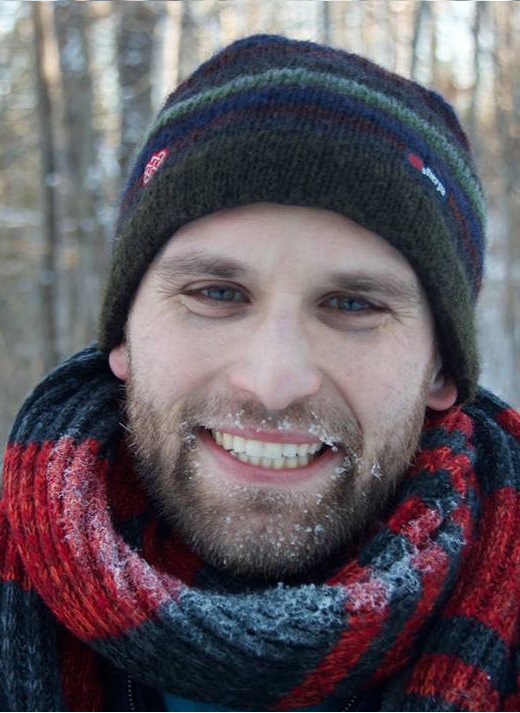
Jared Adelman
Northern Illinois University, USA

Mike Albrow
Fermi National Accelerator Laboratory, USA

Fabio Andrijauskas
Unversity of California San Diego, USA
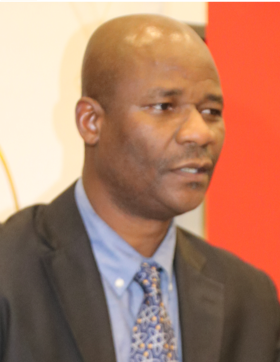
Ketevi Assmamagan
Brookhaven National Laboratory, USA

Diallo Boye
Brookhaven National Laboratory, USA

Vallary Shashikant Bhopatkar
Oklahoma State University, USA
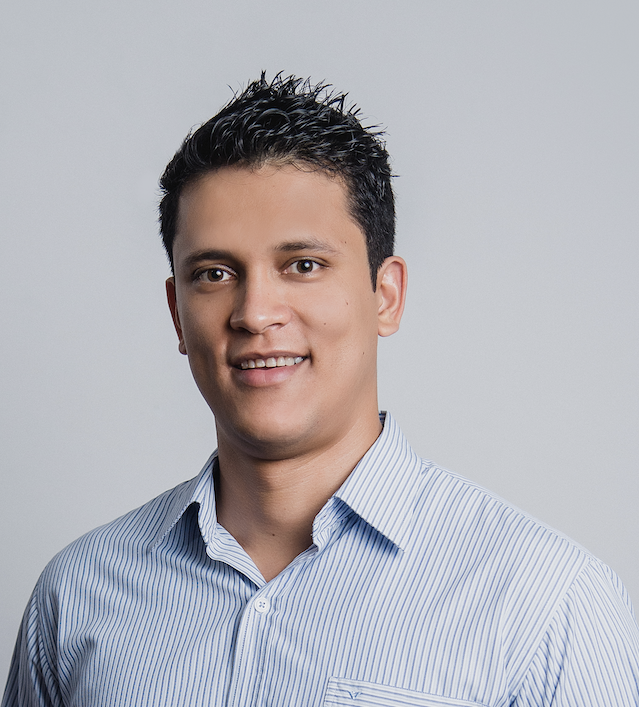
Rodolfo Capdevilla
Fermi National Accelerator Laboratory, USA
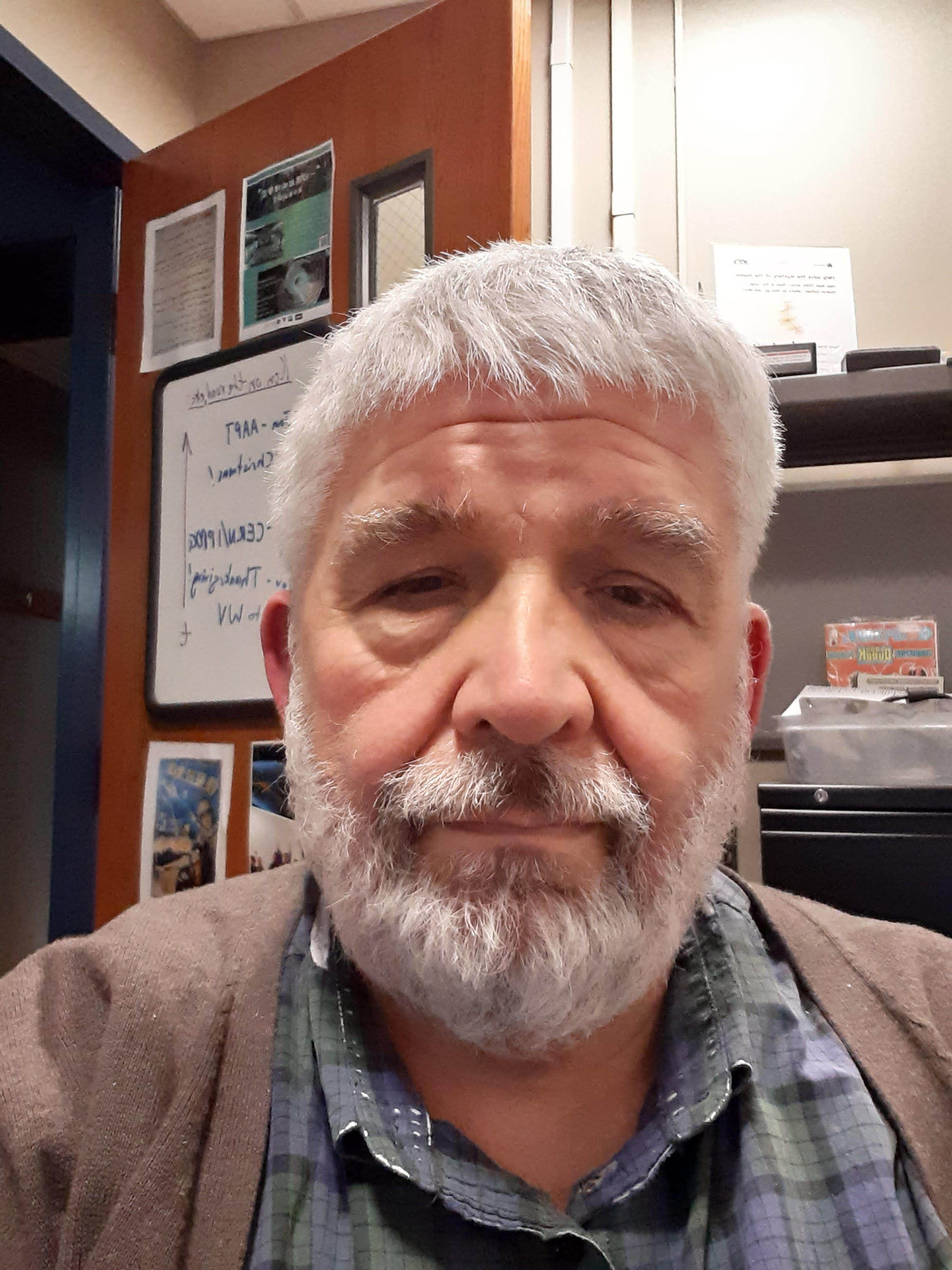
Kenneth Cecire
University of Notre Dame/QuarkNet, USA

Laura Fields
University of Notre Dame, USA

Cecilia E. Gerber
University of Illinois Chicago, USA

Marla Glover
Purdue University, USA
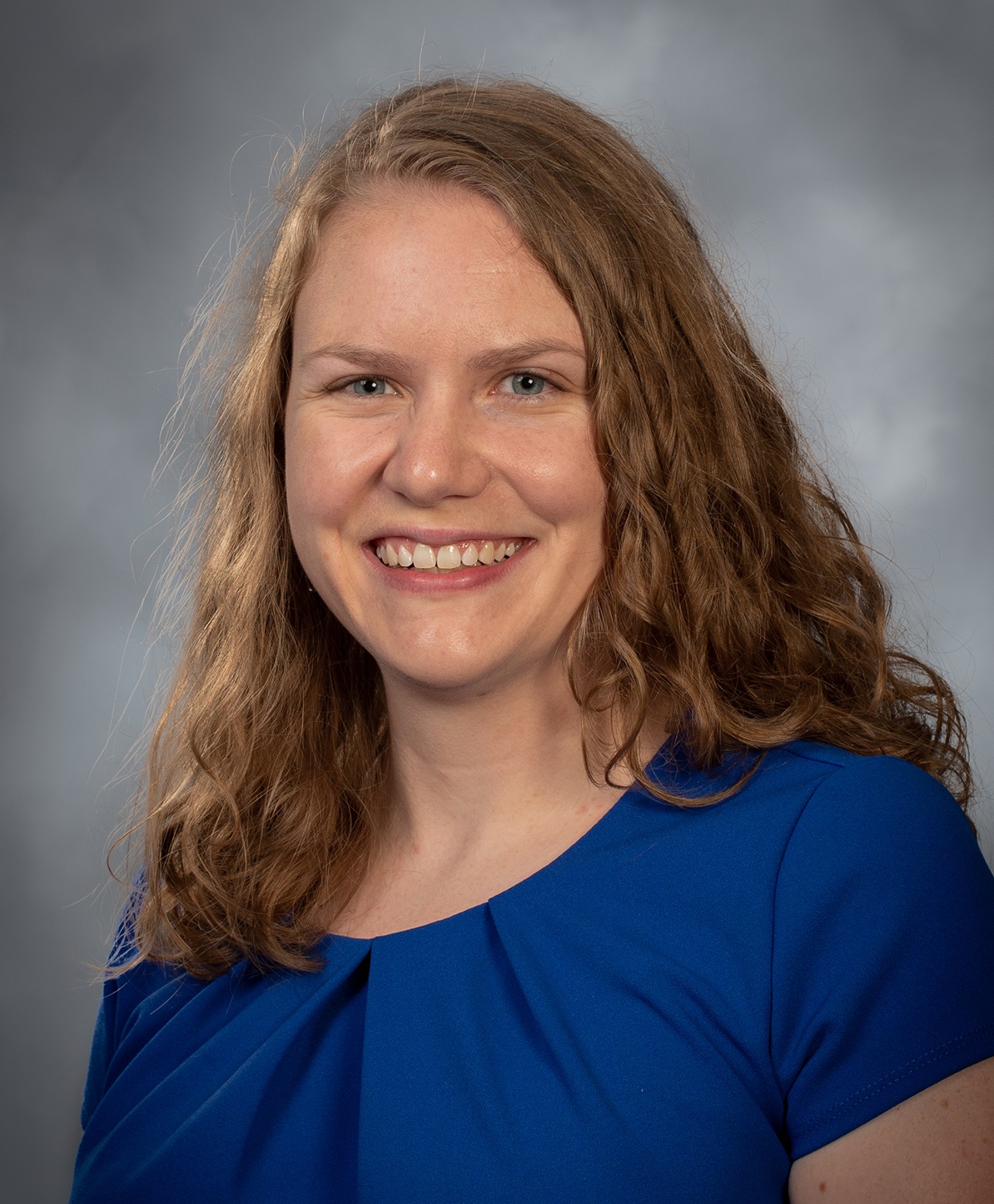
Allison Hall
United States Naval Academy, USA
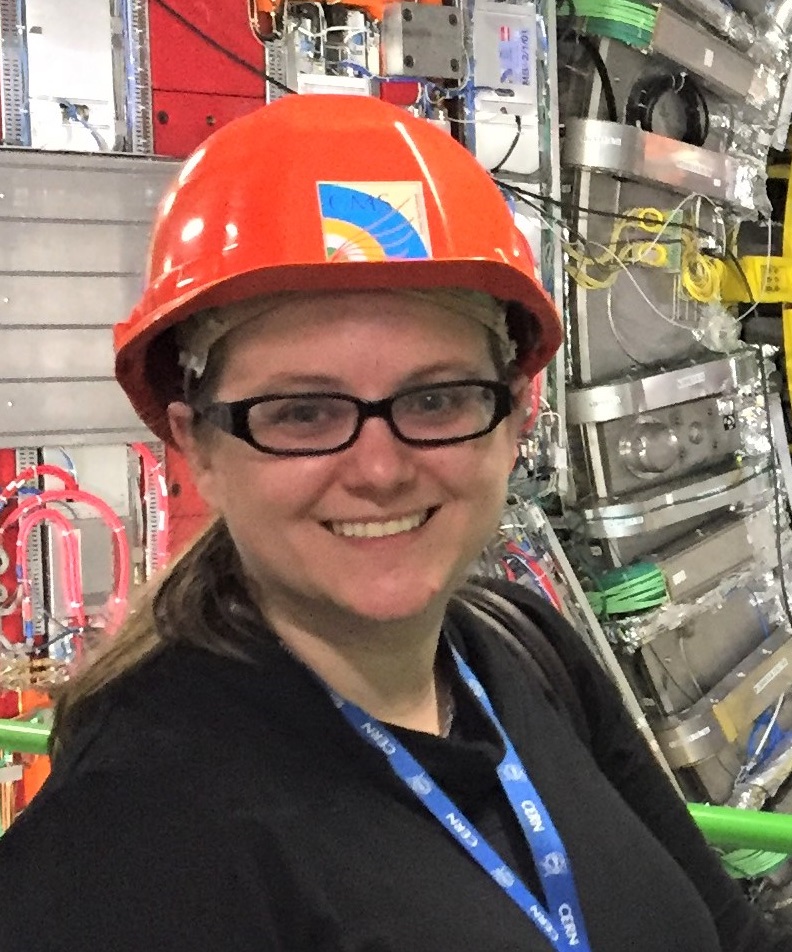
Julie Hogan
Bethel University, USA
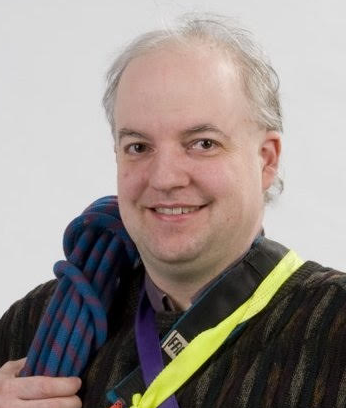
Thomas Junk
Fermi National Accelerator Laboratory, USA
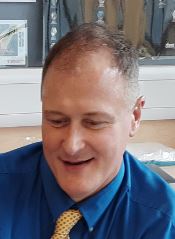
Joel Klammer
Orange Lutheran High School, USA

David Martinez
South Dakota School of Mines and Technology, USA

Kaori Maeshima
Fermi National Accelerator Laboratory, USA

Sudhir Malik
Universidad de Puerto Rico Mayagüez, Puerto Rico (USA)

Sonia Natale
CERN, Switzerland
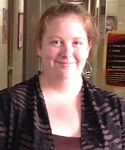
Scarlet Norberg
Fermi National Accelerator Laboratory, USA
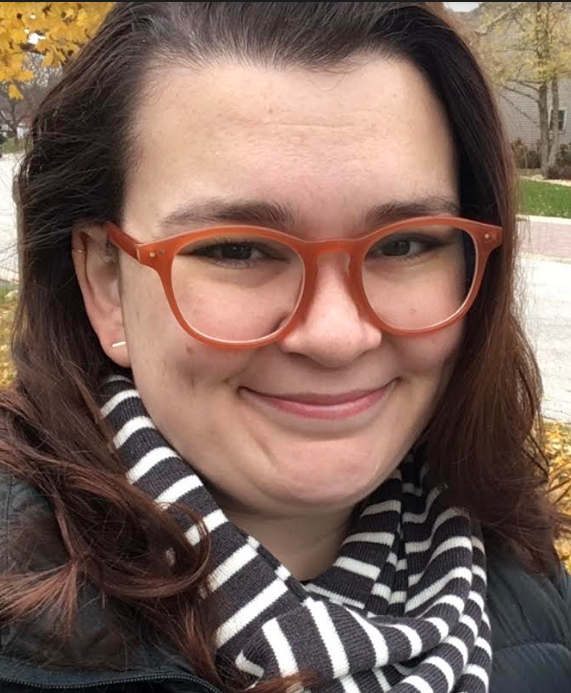
Anne Norrick
Fermi National Accelerator Laboratory, PR (USA)

Pedro Ochoa-Ricoux
University of Califonia Irvine, USA
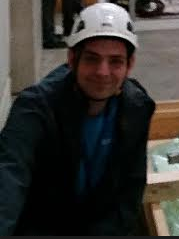
Andrew Olivier
University of Notre Dame, USA
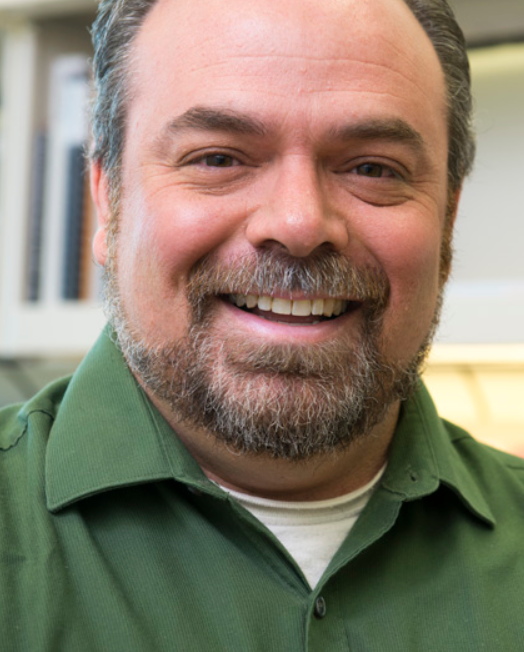
Spencer Pasero
Fermi National Accelerator Laboratory/QuarkNet, USA
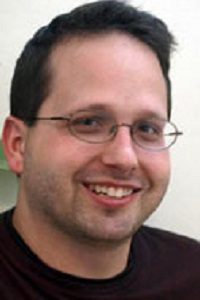
Greg Pawloski
University of Minnesota, USA

Rahmat Rahmat
SCC/University of Iowa, USA
Emily Smith
Fermi National Accelerator Laboratory, USA
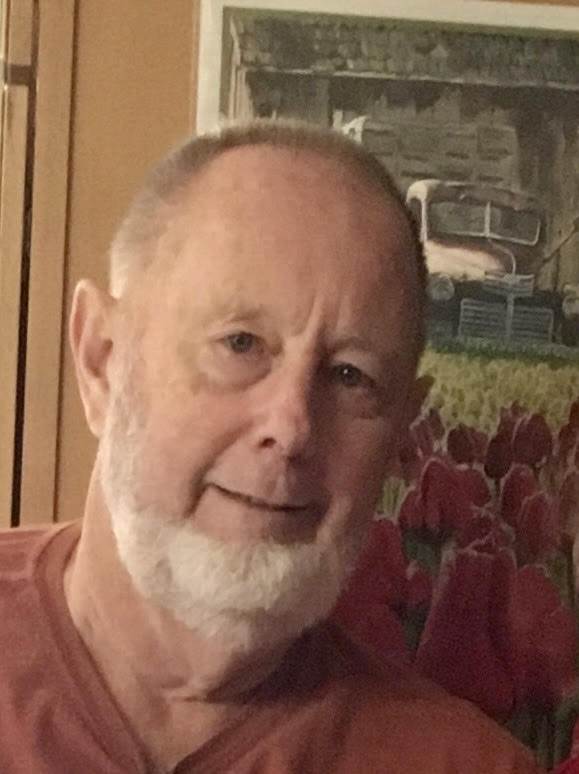
David Trapp
Sequim Science, USA
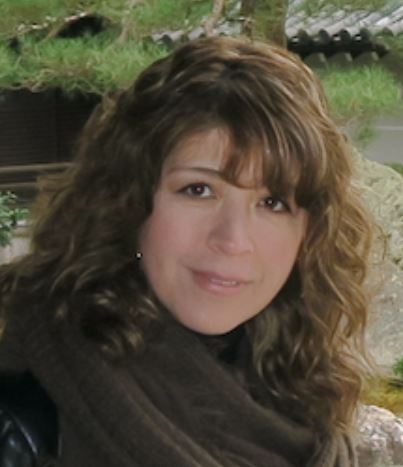
Cecilia Uribe
Benemérita Universidad Autónoma de Puebla, Mexico
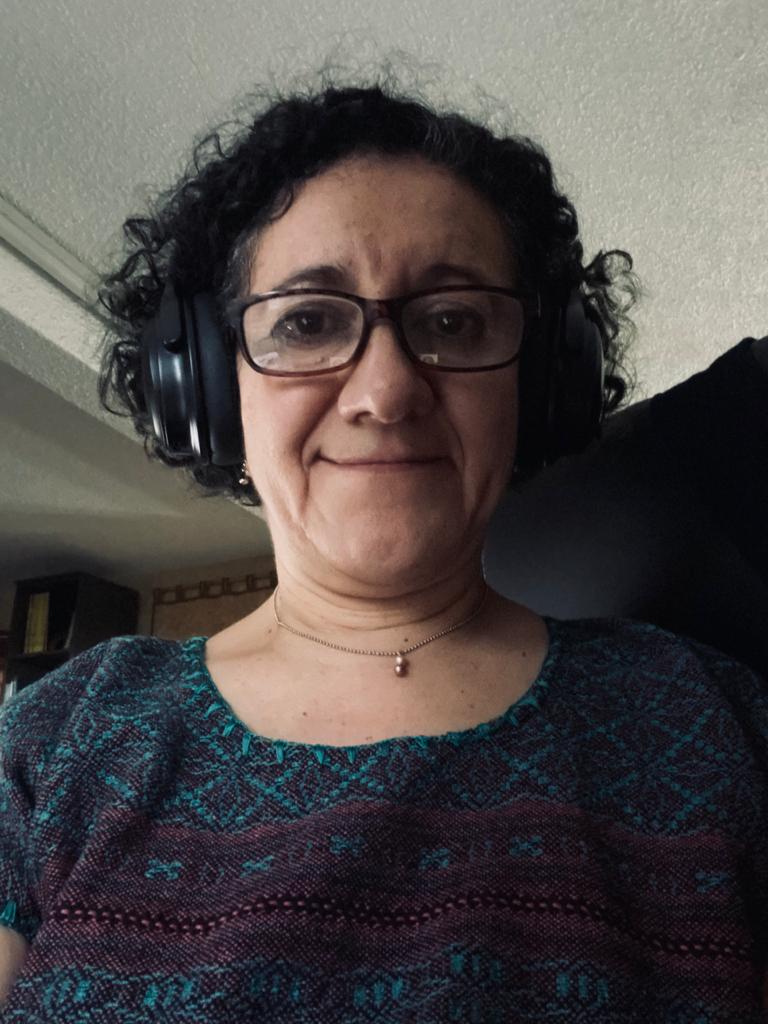
Fabiola Vazquez
Universidad Iberoamericana, Mexico
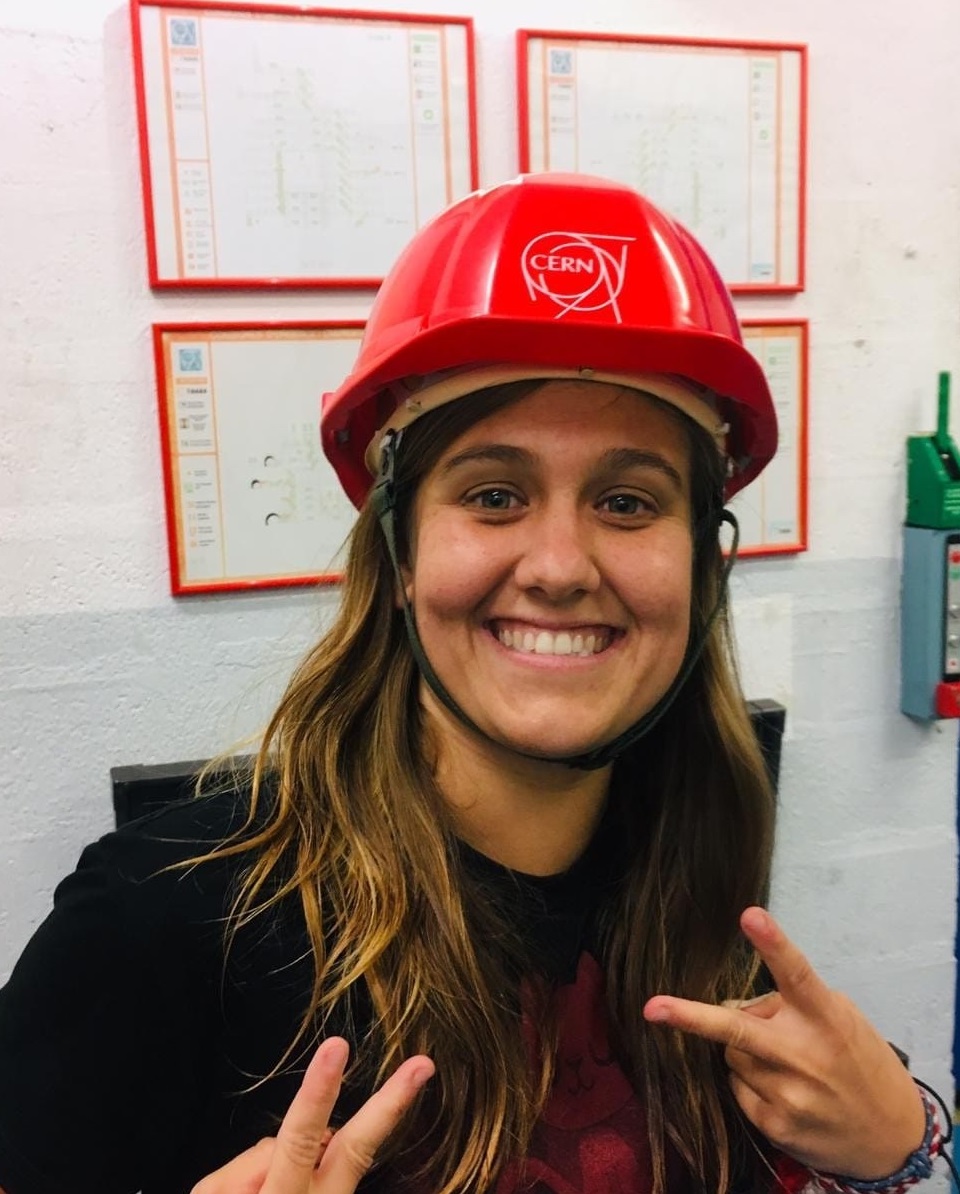
Ana Ventura Barroso
DESY, Germany

Michael Wadness
Medford High School, USA
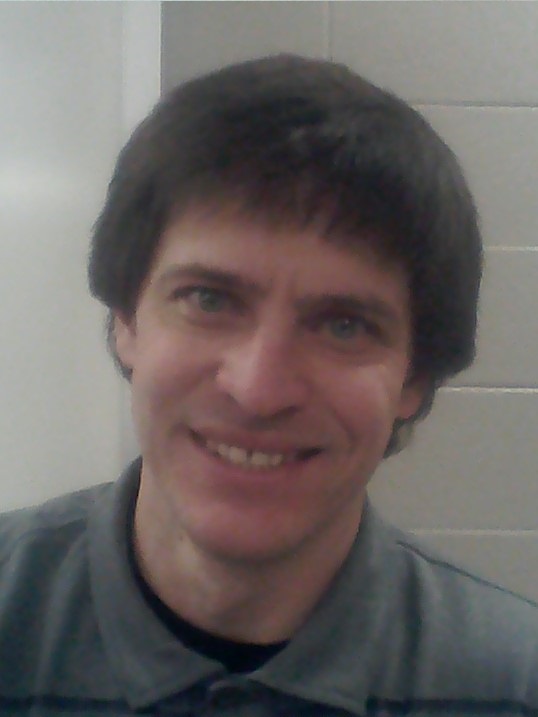
Jeremy Wegner
Winamac Community High School, USA
Susan Wetzler
Plainview-Old Bethpage John F. Kennedy High School, USA

Shane Wood
UMN/QuarkNet, USA

